Basis of Classification
- Books Name
- ACME SMART COACHING Biology Book
- Publication
- ACME SMART PUBLICATION
- Course
- CBSE Class 11
- Subject
- Biology
Animal Kingdom covers about 35 phyla, of which 11 are considered to be major phyla. In major phyla, 10 are from Non-chordates and 1 from the chordates.
HABITAT
The place on the earth, where an animal finds optimum conditions for food and shelter is called its habitat. Habitat can be defined as the physical and geometrical space where an organism lives.
The habitat may be water, soil or earth’s surface. On the basis of their habitat, animals can be of following types :
1. Terrestrial habitat :
Animals which live on land or dry earth’s surface, are said to have terrestrial habitats.
Terrestrial animals are adapted for following types of habitat modes :
a. Aerial or flying : These animals possess wings and therefore can fly. e.g., Birds, bats.
b. Arboreal : These animals mainly live on trees. e.g., Bat, Monkey.
c. Fussorial : These animals live in burrows or underground. e.g., Rabbits, rat, earthworm etc.
d. Scansorial : These animals can climb on walls, rocks etc. e.g., Wall lizard, flying squirrel.
e. Cursorial : These animals are adapted to run very fast. e.g., Tiger, horse, dog etc.
2. Aquatic animals :
These animals live in water. They may be fresh water or marine water.
The aquatic animals may further be of following types :
a. Zooplanktons : The animals which flow passively, with water current, on the surface of water, are called zooplanktons. e.g., many aquatic protozoans, larvae, crustaceans etc.
b. Nektons : These animals can float actively in water body even against water current. e.g., many fishes such as sharks, many skates and rays.
c. Benthos : These animals live at the bottom of the water body. e.g., Deep sea fishes, many echinodermates, sponges and corals.
d. Pelagic : These animals usually live at the surface or water body. These include both zooplanktons and Nektons.
3. Amphibian
These animals living on land as well as in water.
HABITS
Nature of living is called habit. Animals lead various types of life and on this basis, they are of following types:
1. Solitary animals : Animals which have singly (not in groups). e.g., Taenia, Earthworm etc.
2. Colonial animals : Animals which live in groups and form colony. e.g., Volvox, honeybee, termites, wasp etc.
3. Gregarious animals : Animals which live in groups, but do not interact with each other. e.g., locust.
4. Free living animals : Animals, which do not depends on other organisms for food and shelter and live independently. e.g., cat, dog etc.
5. Parasitic animals : Animals which depends on other living organisms for food are called parasitic organisms. e.g., Entamoeba, Taenia, Fasciola, Ascaris, Louse etc.
6. Saprophagous animals : Animals which obtain their food from dead and decaying organisms and organic matter are called saprophagous animals. e.g., house fly etc.
7. Sanguivorous animals : Animals which feed on the blood of other organisms. e.g., Mosquitoes, Leech etc.
8. Sessile (sedentary) animals : Animals which do not move here and there are remain immotile, are called sessile organisms. e.g., Herdmania.
9. Motile animals : Animals, which have locomotory organs and can move here and there, are called motile organisms. e.g., man horse etc.
10. Diurnal animals : Animals, which are active during day time for obtaining their food, are called diurnal organisms. e.g., man, horse, dog etc.
11. Nocturnal animals : Animals, which are active at night for obtaining food are called nocturnal animals. e.g., Cockroach etc.
12. Crepuscular animals : Animals which are active at dusk (evening) for obtaining their food are called crepuscular animals. e.g., rabbit.
13. Vasperal animals : Animals which are active early morning. e.g., Birds.
14. Caprophagous animals : Animals which can eat their own faecal matter to re-digest it. e.g., Rabbit.
Table - Main Phyla of Animal Kingdom
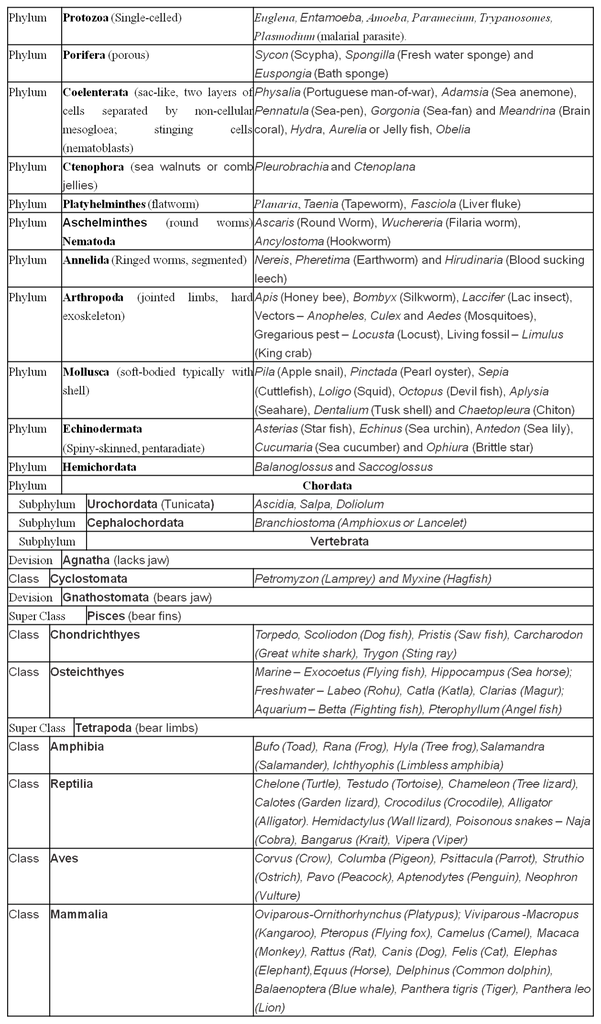
METAZOA
Animal groups are characterised by mobility and the presence of a sensory or a nervous system. These systems receive stimuli from the environment and animals respond by exhibiting some behaviour.
The only exception is of poriferans (pore-bearers) or the sponges. They have no cell that can be termed as nerve cell.
Like plant life, early animal life also arose in sea. The animals which live on the sea floor are called Benthonic (e.g., echinoderms, corals and deep sea fishes), whereas those which swim about actively in sea are called Nektons.
The multicellular eukaryotic organisms with holozoic mode of nutrition are called metazoans. Based on complexity of organisation, metazoans are further sub-divided into two sub-kingdoms, Parazoa and Eumetazoa.
(a) Parazoa: Parazoa include the sponges in which the cells are loosely aggregated and do not form tissues or organs.
(b) Eumetazoa: Eumetazoa includes the rest of animals in which the cells are organised into structural and functional units called tissues, organs and organ systems.
LEVELS OF ORGANISATION
1. Cellular Level :
Though all members of Animalia are multicellular, all of them do not exhibit the same pattern of organisation of cells.
For example, in sponges, the cells are arranged as loose cell aggregates, i.e., they exhibit cellular level of organisation.
Some division of labour (activities) occurs among the cells.
2. Tissue Level :
In coelenterates and ctenophores, the arrangement of cells is more complex.
Here the cells performing the same function are arranged into tissues, hence it is called tissue level of organisation.
3. Organ Level :
A still higher level of organisation, i.e., organ level is exhibited by members of Platyhelminthes and other higher phyla where tissues are grouped together to form organs, each specialised for a particular function.
In animals like Annelids, Arthropods, Molluscs, Echinoderms and Chordates, organs have associated to form functional systems, each system concerned with a specific physiological function.
This pattern is called organ system level of organisation. Organ systems in different groups of animals exhibit various patterns of complexities.
For example, the digestive system in Platyhelminthes has only a single opening to the outside of the body that serves as both mouth and anus, and is hence called incomplete.
A complete digestive system has two openings, mouth and anus.
Similarly, the circulatory system may be of two types:
(i) Open type
(ii) Closed type
(i) Open type:
In this, the blood is pumped out of the heart and the cells and tissues are directly bathed in it. The blood is pumped by the heart into the blood vessels that open into blood spaces (sinuses).
There is no capillary system (e.g., in most arthropods, non-cephalopod molluscs and tunicates). These sinuses are actually the body cavities and are called the haemocoel.
The pressure of the blood is low; it moves slowly between the tissues, and finally, returns to the heart via the open-ended blood vessel
(ii) Closed type :
Many invertebrates and all the vertebrates, including humans, have a closed circulatory system. In closed type, the blood flows inside the body through a series of blood vessels of varying diameter (arteries, veins and capillaries).
In this system, the same blood regularly circulates in the body under high pressure and returns back to the heart without leaving the system of tubes.
SYMMETRY
The animals can be categorised on the basis of their body symmetry:
(i) Radial symmetry: When any plane passing through the central axis of the body divides the organism into two identical halves, it is called radial symmetry. The animals with radial symmetry are put in the group Radiata. For example, cnidarians (hydra and jelly fish). Biradial symmetry is present in sea anemone, ctenophores.
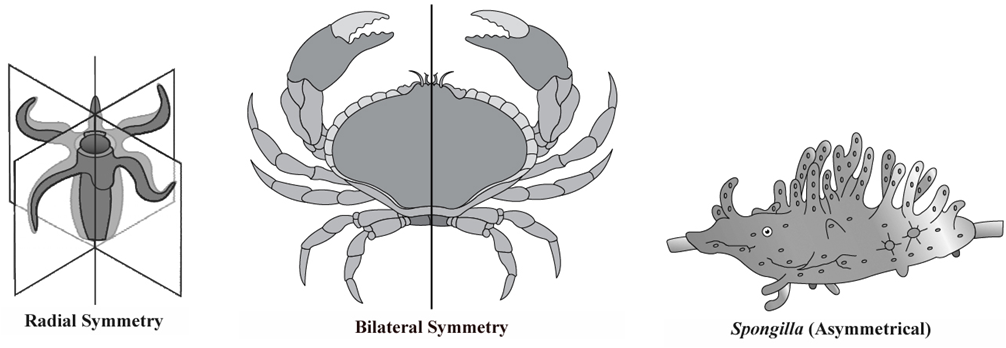
(ii) Bilateral symmetry: The animals with bilateral symmetry are put in group Bilateria. The body can be divided into identical right and left halves in only one plane. For example, platyhelminthes, annelids, arthropods etc. (platyhelminthes to chordates).
(iii) Asymmetry: Asymmetric organisms cannot be divided along any plane to produce two equivalent halves. Sponges are mostly asymmetrical.
GERM LAYERS
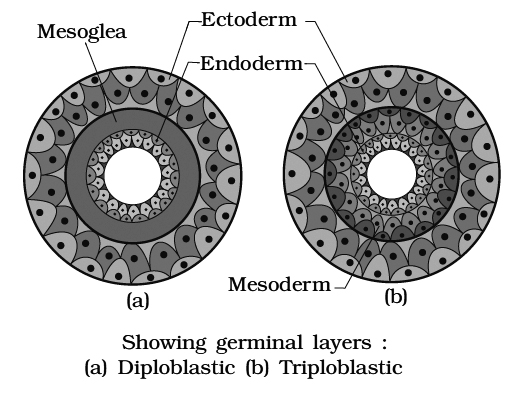
Germ layers give rise to all the tissues/organs of the fully formed individuals. On the basis of number of germ layers animals can be
1. Diploblastic: In diploblastic animals, the body cells are arranged in two layers-an outer ectoderm and an inner endoderm with an intervening undifferentiated mesoglea. e.g. Coelenterates.
2. Triploblastic: If the body wall in animals is made of three germ layers i.e. ectoderm, mesoderm and endoderm, they are called triploblastic animals. e.g., Platyhelminthes to chordates.
BODY PLAN
Though diverse in shape and size, animals have body that fits in one of the three basic plans:
1. Cell aggregate : Cell aggregate type of body plan is present in sponges. They are clusters of cells with a rudimentary division of labour among them. There are no tissues, or organs.
2. Blind sac : Blind sac type of body plan is present in platyhelminthes and coelenterates where the alimentary canal has only one opening.
3. Tube within tube : Tube-within tube type of body plan is present in Nemathelminthes, Annelida, Arthropoda, Mollusca, Echinodermata and Chordata. The digestive system is a continuous tube with an opening at both end.
BODY CAVITY OR COELOM
Presence or absence of cavity between the body wall and the gut wall is very important for classification
1. Acoelomate : The animals in which the coelom is absent are called acoelomates, for example poriferans, coelenterates, ctenophores, flatworms. In flatworms, the spaces between various organs are filled with special tissue called parenchyma.
2. Pseudocoelomate : The body cavity is not completely lined with mesoderm. Instead, the mesoderm is present as scattered pouches in between the ectoderm and endoderm. Such a body cavity is called pseudocoelom e.g. in roundworm.
3. Eucoelomate : The true coelom is a body cavity which arises as a cavity in embryonic mesoderm. In this case, the mesoderm of the embryo provides a cellular lining, called coelomic epithelium or peritoneum, to the cavity. The coelom is filled with coelomic fluid secreted by the peritoneum. True coelom is found in annelids, echinoderms and chordates. True coelom is of two types:
- Schizocoelom : It develops by the splitting up of mesoderm. It is found in annelids, arthropods and molluscs. Body cavity of arthropods and non-cephalopod molluscs is called haemocoel.
- Enterocoelom : The mesoderm arises from the wall of the embryonic gut or enteron as hollow outgrowths or enterocoelomic pouches. It occurs in echinoderms and chordates.
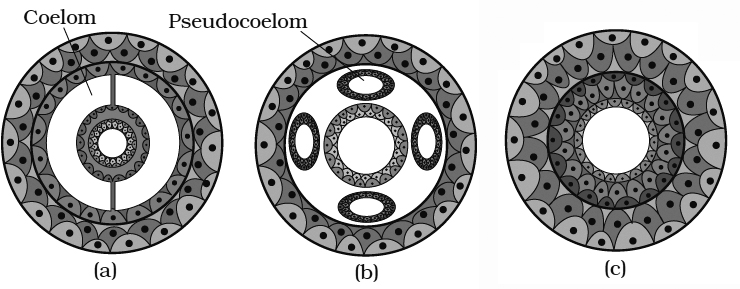
Segmentation
In some animals, the body is externally and internally divided into segments with a serial repetition of at least some organs.
For example, in earthworm, the body shows this pattern called metameric segmentation and the phenomenon is known as metamerism.
Metameric segmentation is present in annelids only.
Notochord
Notochord is a mesodermally derived rod-like structure formed on the dorsal side during embryonic development in some animals. Animals with notochord are called chordates and those animals which do not have this structure are called non-chordates, e.g., porifera to echinoderms.
Basis of Classification
Basis of classification in Animals
Despite differences in structure and shape across animals, there are essential similarities in cell organization, body symmetry, coelom type, and digestive, circulatory, and reproductive system patterns. These characteristics are used to classify animals, and some of them are covered here. The requirement for classification grows in importance as more than a million species of animals have been described to date. Newly described species can also be assigned a systematic position thanks to categorization.
A. Level of organization: Even though all members of Animalia are multicellular, they do not all have the same cell organization pattern. Sponge cells, for example, are grouped as loose cell aggregates, indicating that they have a cellular level of organization. Among the cells, there is some division of labour (activities). The cell arrangement in coelenterates is more complicated. The cells that perform the same function are grouped together ies, which is referred to as the tissue level of organization. Members of the Platyhelminthes and other higher phyla have an even higher degree of organization, namely the organ level, in which tissues are gathered together to form organs, each specialized for a certain function. Organs have come together to form functional systems in creatures including Annelids, Arthropods, Molluscs, Echinoderms, and Chordates.
B. Symmetry: The symmetry of animals can be used to classify them. Sponges are generally asymmetrical, which means that any plane passing through the centre split them in half evenly. Radial symmetry occurs when any plane traveling through the body's central axis divides the organism into two identical halves. This is the body plan of coelenterates, ctenophores, and echinoderms. Bilateral symmetry is found in animals such as annelids, arthropods, and others whose bodies can be divided into identical left and right halves in just one plane.
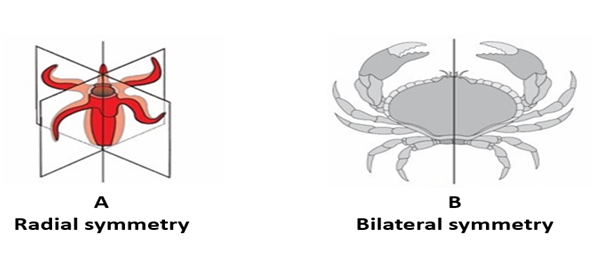
C. Germinal layers: During embryonic development, a germ layer is the first layer of cells that arises. Gastrulation is the process through which an early embryo develops three germ layers. Ectoderm, endoderm, and mesoderm are the three types of cellular layers that make up the body. Diploblastic creatures, such as coelenterates, have their cells organized in two embryonic layers, external ectoderm, and an internal endoderm. Between the ectoderm and the endoderm, there is an undifferentiated layer called mesoglea. Triploblastic animals are those in which the growing embryo has a third germinal layer, mesoderm, between the ectoderm and endoderm.
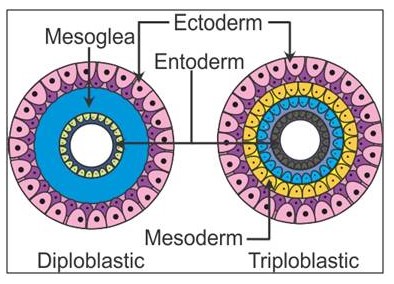
D.Coelom: When it comes to classification, the presence or absence of a cavity between the body wall and the gut wall is crucial. The coelom is the name for the bodily cavity that is lined by mesoderm. Coelomates are animals that have a coelom, such as annelids, mollusks, arthropods, echinoderms, hemichordates, and chordates. Mesoderm does not line the body cavity of some animals; instead, it appears as scattered pouches in between the ectoderm and endoderm. Pseudocoelom is the name for such a bodily cavity, and animals with them are known as pseudocoelomates, such as aschelminthes. Acoelomates, such as Platyhelminthes, are animals that do not have a body cavity.
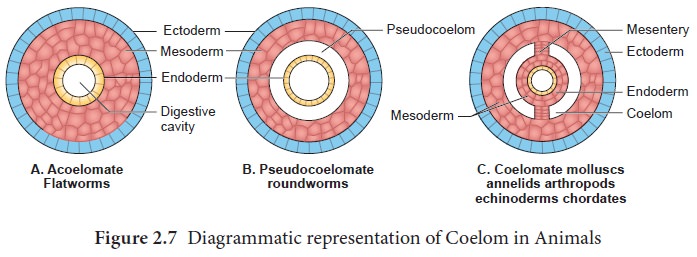
E. Segmentation: The body of several animals is divided into segments both visibly and internally, with at least some organs repeating serially. The body of an earthworm, for example, displays a pattern known as metameric segmentation, and the phenomenon is known as metamerism.
F. Notochord: In some animals, the notochord is a mesodermally derived rod-like structure that forms on the dorsal side during embryonic development. Chordates are creatures that have a notochord, while non-chordates are animals that do not have one, such as Porifera and Echinoderms.
The broad classification of Animalia is based on common fundamentalfeatures as discussed above. A schematic diagram for the same is given below.
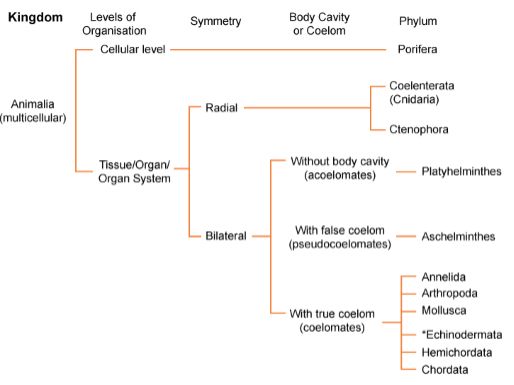
Classification of Animals
- Books Name
- ACME SMART COACHING Biology Book
- Publication
- ACME SMART PUBLICATION
- Course
- CBSE Class 11
- Subject
- Biology
TABLE : Salient Features of Different Phyla in the Animal Kingdom

Phylum : Porifera
- Books Name
- ACME SMART COACHING Biology Book
- Publication
- ACME SMART PUBLICATION
- Course
- CBSE Class 11
- Subject
- Biology
PHYLUM: PORIFERA (Sponges)
These are primitive, multicellular, asymmetrical (except Leucosolenia, Scypha) organisms having cellular level of organisation.
Most of them are marine and remain attached to rocks (sessile). A few live in fresh water e.g., Spongilla. This is the only phylum in animal kingdom without any nerve cells.
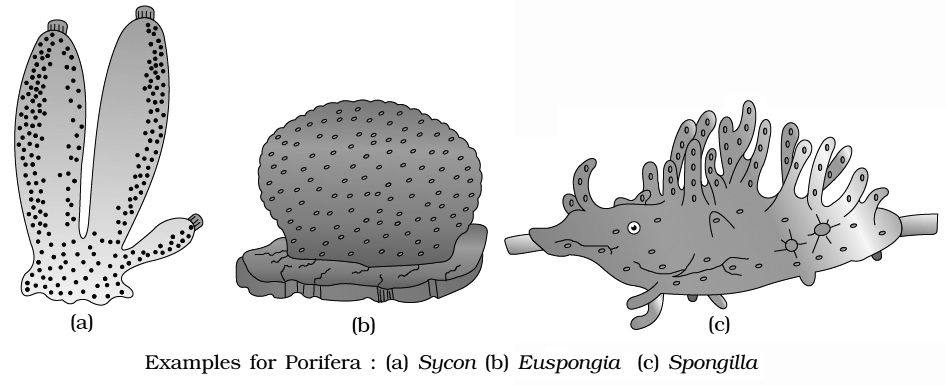
Important characters of phylum porifera
1. Body wall: The body wall of a common sponge consists of following layers:
(a) Pinacoderm (dermal layer)
It is outer cellular layer which consists of (i) flattened pinacocytes and (ii) oval porocytes
(b) Choanoderm (gastral layer) :
It is inner cellular layer which consists of highly specialized flagellated cells called choanocytes (collar cells).
They are the characteristic cells of this phylum responsible for ingestion of food, secretion of mesohyal and differentiation of sex cells.
(c) Mesohyl layer (mesenchyme) :
Basically, it is a noncellular layer found between pinacoderm and choanoderm. It has fine dispersed spongin fibres and numerous spicules.
It also contains amoebocytes (amoeba-like cells) of both pinacoderm and choanoderm.
Amoebocytes are modified into the following types :
- Archaeocytes. They may be converted into other types of cells and are also called undifferentiated "totipotent" cells.
- Trophocytes. They provide food to developing cells and are called nurse cells.
- Thesocytes. They store food granules.
- Gland cells. They secrete a slimy substance.
- Spongioblasts. They secrete spongin fibres of the mesohyllayer.
- Scleroblasts. They secrete spicules. In calcareous sponges, they are called calcoblasts and in silicious sponges, they are called silicoblasts.
- Collencytes. They secrete collagen fibers and form connective tissue.
- Myocytes. They form a circular ring around the osculum and help in closing and opening of the osculum.
- Germ cells (Sex cells). They form sperms and ova and develop during breeding season.
- Chromocytes. They contain pigment granules and excretory substances.
(xi) Phagocytes. They collect food from choanocytes through their pseudopodia and also engulf excreta and damaged tissues.
2. The central body cavity of a sponge is called spongocoel or paragastric cavity.
3. The continuous water current flowing through the canal system is very important for the life of a sponge. It brings in food and oxygen and carries away carbon dioxide, nitrogenous wastes and reproductive bodies. Thus the canal system helps the sponge in nutrition, respiration, excretion and reproduction.
4. Skeleton: Almost all sponges possess an internal skeleton. It may consist of calcareous or siliceous spicules or of fine spongin fibres or both, located in the mesohyl layer.
5. Digestion: It is intracellular and takes place inside food vacuoles as in protozoans.
6. Circulation: Distribution of food from the ingesting cells to others is brought about by wandering amoebocytes of mesohyl layer.
7. In case of Sycon, pinacoderm is divided into exopinacoderm and endopinacoderm. Exopinacoderm lines the incurrent canal and the spongocoel. Radial canals are lined by flagellated choanocytes.
Concept Builder
What is luffa sponge?
A luffa sponge isn't a sponge at all but a gourd. When dried, the fibrous material found in gourd forms a "skeleton" similar to that of some sponges. It can be used for the same purposes e.g., scrubbing.
8. Canal System: The body of a sponge is organized in such a manner as to form a complex system of pores and canals. This system is called canal system. It is meant for food gathering, respiration and removal of waste.
- Three types of canal systems are found in sponges:
(i) Ascon type : It is the simplest type of canal system which is found in Leucosolenia and few other sponges.

(ii) Sycon type : It is more complex than the ascon type. It is found in Sycon and some other sponges.

(iii) Leucon type : It is most complex canal system which is found in Spongilla and some other sponges.

In Demospongiae, the leuconoid condition is derived from a larval stage, called the rhagon. It is a conical organism with a flattened base. The canal system of rhagon larva does not occur in any adult sponge. Because of its derivation from rhagon stage in Demospongiae, the leucon type of canal system is also called the rhagon type.
9. Respiration: Exchange of gases occurs by diffusion through the plasma membranes of the cells as in protozoans.
10. Excretion: Removal of metabolic wastes also occurs by diffusion through the plasma membranes of the cells as in protozoans. Ammonia is chief excretory waste.
11. Reproduction: Both asexual and sexual reproduction occur in sponges. Asexual reproduction occurs by fragmentation, budding and gemmules. They are hermaphrodite and show internal fertilization.
12. Development: Zygote undergoes holoblastic cleavage (complete division). The development is indirect and includes a free swimming larva, the amphiblastula (in Sycon) or parenchymula (in Leucosolenia and other Porifers) for dispersal of the species.
CLASSIFICATION
Based on the type of skeleton, phylum Porifera is divided into three classes.
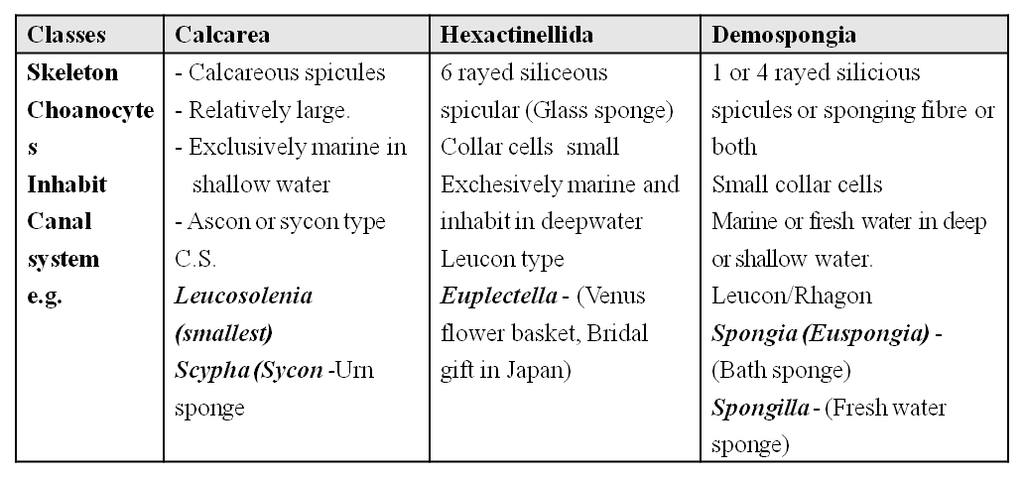
Concept Builder
Cultural Awarness
1. Using sponges: For centuries, people around the world have used natural sponges with spongin skeletons for cleaning, bathing by taking advantage of these sponges' soft flexible and highly porous bodies.
e.g., Euspongia. The ancient Greeks also used sponges as padding inside helmets.
2. Spongin fibres are elongated protein fibres which form a fibrous network.
3. Digestion in sponges is intracellular.
4. Regeneration in sponges was demonstrated by H.V.Wilson (1907). It is brought about by archaeocyte cells.
5. Sponge cells, seperated by straining pieces of sponge through a fine net, can reaggregate and grow into a sponge. So, a sponge is a republic of cells which identify one another, aggregate and grow together.
6. Sponge reproduces asexually by fragmentation. During sexual reproduction, some cells become egg or sperm cells. After fertilisation, the zygote develops into a flagellated larva which swims, settles in a new place and grows into a sponge.
7. Proterospongia is a connecting link between protozoa and porifera.
8. In Hyalonema, root tuft consists of bundle of long anchoring spicules. These may pass through the columella (body axis) as gastral cone. It is commonly known as glass rope sponge.
9. Euspongia is commonly found is Mediterranean sea. It is commonly known as Bath sponge.
10. Amphiblastula is the hollow larva of Sycon etc. whereas parenchymula is the solid larva of most of sponges, e.g., Leucosolenia.
Phylum : Porifera
Phylum Porifera
This animal group comprises Sponges and is thought to be the oldest on the planet. Sponges are the most basic multicellular creatures. They don't have any tissues or organs, despite being multicellular. Sponges need to be near water, thus they dwell in an aquatic environment. Water is essential for nutrient absorption, gas exchange, and excretion. The sponges' bodies have numerous holes or pores known as Ostia. Sponge bodies are built so that water can circulate through them, filtering out food and absorbing dissolved oxygen while also removing waste.This phylum of organisms lacks a specialized digestive, neurological, or circulatory system. Instead, they have a canal or water transport system that performs the activities of digesting, excretion, and gas exchange.
Their bodies are asymmetrical, and their design has been optimized to facilitate the most efficient flow of water via the core hollow that is present inside. Bacteria and other food particles found in the water are their main sources of nutrition. The spongocoel is a huge central hollow canal in their bodies. Water enters the spongocoel through the Ostia and exits through the osculum. Choanocytes or collar cells, with their flagellum jutting out, line up the spongocoel and canals.The water is moved throughout the sponge's body by the beating of this flagellum from all choanocytes. Common examples areSycon (Scypha), Spongilla (Freshwatersponge), and Euspongia(Bath sponge).
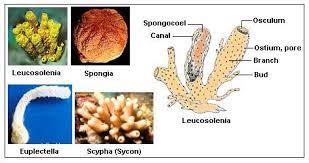
Phylum : Coelenterata (Cnidaria)
- Books Name
- ACME SMART COACHING Biology Book
- Publication
- ACME SMART PUBLICATION
- Course
- CBSE Class 11
- Subject
- Biology
PHYLUM: CNIDARIA (Coelenterata
- The phylum Cnidaria (the old name is Coelenterata) includes about 9,000 species, mainly marine. They are sessile, free swimming, radially symmetrical invertebrates and more complex than sponges
- General characters of this phylum are as follows:
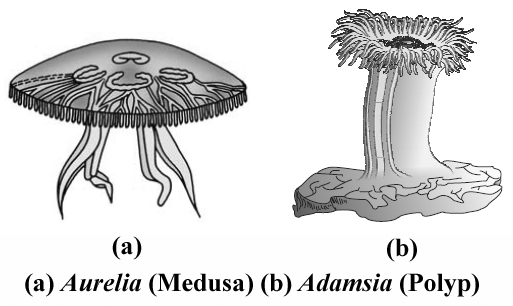
1. Cnidarians exhibit a blind sac body plan and are radially symmetric. They are more advanced than sponges in having true tissues. They are, however, acoelomate.
2. Body wall consists of only two cell layers, the ectoderm and the endoderm, separated by a jelly-like mesoglea. These animals are therefore diploblastic, that is, arising from two embryonic cell layers.
Concept Builder
Body wall in coelenterates (with reference to Hydra).
They are diploblastic animals i.e., they are derived from two layers-ectoderm and endoderm. These germ layers form the epidermis and gastrodermis.
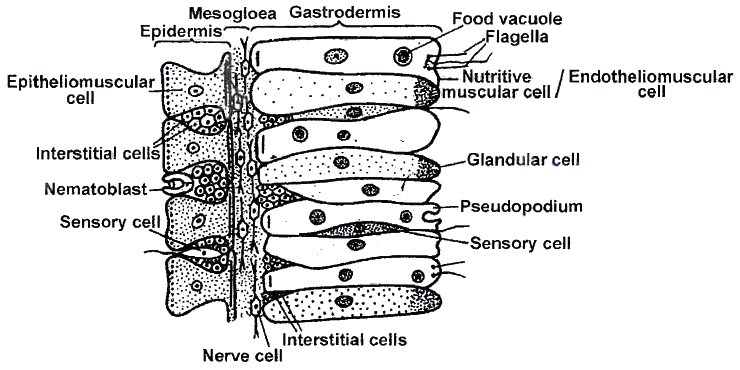
(1) Epidermis: The various epidermal cells are:
(a) Epithelio-muscular cells: Each cell has two functional parts, the outer epithelial part, extending to the body surface and the basal muscular part drawn out into two muscle processes along the longitudinal axis of the body. The muscle processes contain a contractile fibril myoneme.
(b) Glandulo-muscular cells : The epithelio-muscle cells, chiefly in the region of the pedal disc, are especially modified to secrete sticky material for attachment of animal to substratum.
(c) Interstitial cells: They are totipotent cells which give rise to all the different cells of the body.
(d) Sensory cells: They are scattered throughout the epidermis. They are most numerous on the tentacles, hypostome and basal disc. They receive and transmit impulses.
(e) Nerve cells: They occur for the first time in coelentrates. They are present at the base of epithelio-muscle cells. They conduct impulses in all the directions.
(f) Germ cells : They remain in restricted regions. They proliferate to form gonads. They are ectodermal in hydrozoa and endodermal in Scyphozoa and Anthozoa.
(g) Cnidoblasts : Many of the interstitial cells of the epidermis become specialized to form the stinging cells, called the cnidoblasts. They migrate to the tentacles through the mesoglea by means of amoeboid movements. Projecting cnidoblasts act as organs for offence and defence.
Structure:
- The cytoplasm of a cnidoblast contains a conspicuous nucleus lying to one side, and a peculiar oval or pyriform sac filled with a poisonous fluid, hypnotoxin. The sac is a part of stinging apparatus, known as the nematocyst (stinging structure).
Occurence of nematocysts :
- The nematocysts occur scattered mostly singly, throughout the epidermis of the body but remain absent on the basal disc.
- They are abundant in the epidermis of the oral region and the tentacles where they cluster as wart-like "nematocyst batteries".
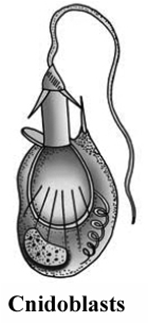
Difference between four nematocyst

(2) Gastrodermis: It is the inner layer of the body. The cells are of following types :
(a) Endothelio-muscle or nutritive muscle cells : They help in contraction of the body and nutrition.
(b) Endothelio-gland cells : They secrete digestive enzymes in coelenteron. In the region of hypostome and mouth are found mucous gland cells. Gland cells are absent in the tentacles and basal disc.
(c) It also contains interstitial cells, sensory cells and nerve cells but no cnidoblasts.
(3) They enclose gastrovascular cavity (coelenteron), having single opening hypostome. Their digestion is intra and extracellular.
Concept Builder
1. The green colour of Chlorohydra viridissima comes from alga Chlorella vulgaris (Zoochlorella), that lives inside the gastrodermal cells of Hydra in symbiotic relationship.
2. Corallium rubrum (red coral) has been used widely in jewellery and known as red moonga.
HYDRA

- Some important characters of Hydra are :
(i) Hydra flourishes well in cool, clean and stagnant water.
(ii) Number of tentacles surrounding mouth in Hydra is 6-10. Tentacles of Hydra are hollow while that of obelia are solid.
(iii) Food of Hydra is water fleas (Daphnia and Cyclops). Thus, it is carnivorous. It cannot digest starch.
(iv) No free larval stage in development of Hydra. Hence, development is direct.
(v) Most species of Hydra are dioecious/unisexual.
(vi) Male Hydra bears 1-8 conical testes towards distal end whereas female Hydra bears 1-2 rounded ovaries towards proximal end of the body.
(viii) Locomotion in Hydra occurs by looping, somersaulting, gliding, walking and floating etc.
METAGENESIS AND POLYMORPHISM
- Colenentrata members shows polymorphism most common is polyp & medusa forms.
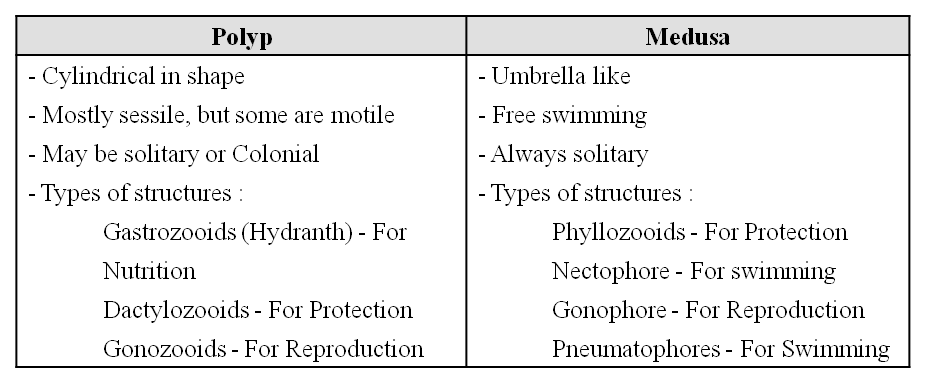
- In the life-cycle there is an alternation of the asexual polyp phase and the sexual medusa phase and it is termed as Metagenesis.
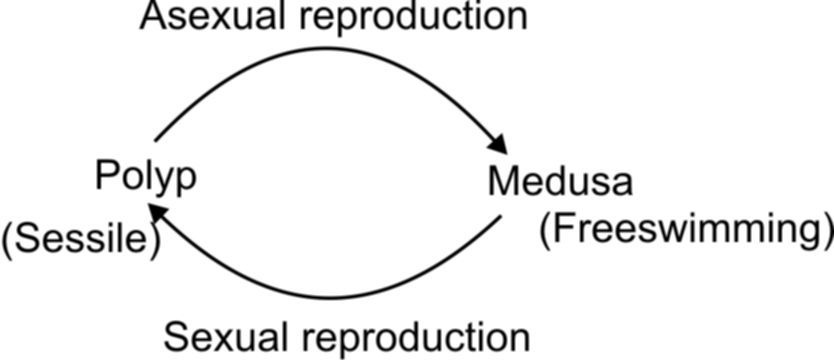
- During sexual reproduction, medusae liberate gametes into water. Following fertilization, the zygote forms a ciliated larva called Planula, which swims, settles and grows into a sessile polyp. (Some cnidarians, like Hydra, do not have a medusa stage. Hydra has no larval form, no metagenesis).
- Polyps reproduce asexually by budding where as, medusa liberates gametes into water during 'Sexual reproduction. Both asexual and sexual forms are free living.
CLASSIFICATION
Chiefly on the basis of the dominance of medusoid or polypoid phase in the life cycle, the phylum Cnidaria is divided into three classes

Concept Builder
Coral Reefs :
- A coral reef is a ridge or mound in a shallow, tropical sea, has its upper surface near the surface of water, supports a variety of animals and plants. It is formed of calcium carbonate produced by some of its inhabitant, chiefly medreporarian corals. Coral reefs form stable marine ecosystems. The coral reefs are of three kinds :
(i) Fringing Reefs : The coral reefs lying close to the shores of some volcanic island or part of some continent are called the fringing reefs. Hawaiian is lands are an ideal example of permanent fringing reefs.
(ii) Barrier Reefs : They are like the fringing reefs but are located some distance from the shore. The stretch of water of lagoon separates the barrier reefs from land. Australia's Great Barrier Reef is an example of such a reef which is about 900 nautical miles long and 90 miles from sea shore.
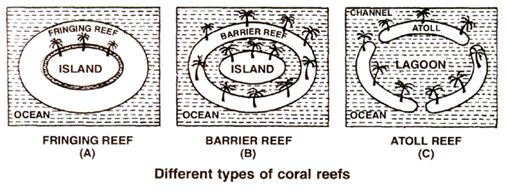
(iii) Atoll reefs : An atoll reef is also called coral island or lagoon island which is a circular or horse shoe shaped reef that encircles a lagoon but not an island. It may be complete or broken by a number of channels of which only a few are navigable. The Lakshadweep and Maldive islands in the Indian Ocean are composed of Atoll reef.
Phylum : Coelenterata (Cnidaria)
Phylum Coelenterata
They are also known by the name Cnidaria. They are radially symmetrical aquatic, primarily marine, sessile, or free-swimming organisms. Typically, these are invertebrate species with a very basic tissue arrangement. Coelenterates can be found in colonies or alone. Coelenterates are the simplest animal group with genuine tissues and the coelenteron or gastrovascular cavity as a distinguishing feature. The word Cnidaria comes from the stinging capsules or nematocysts found on the tentacles and body, which are called Cnidoblasts or Cnidocytes. Cnidoblasts are the phylum Cnidaria's distinguishing trait.They contain stinging capsules called nematocysts. It aids in both prey capture and defence. Cnidoblasts are employed for prey capture, defence, and anchoring. Cnidarians are diploblastic and have tissue-level organization. They have a single aperture in the center of their gastro-vascular cavity, and their mouth is hypostome. Extracellular and intracellular digestion are both involved.The skeleton of some cnidarians, such as corals, is made of calcium carbonate. Polyp and medusa are the two primary body types of cnidarians. The former, like Hydra, Adamsia, and others, are sessile and cylindrical, whereas the latter, like Aurelia or jellyfish, is umbrella-shaped and free-swimming. Cnidarians often show alternation of generations (Metagenesis). When both polyps and medusae exist within a Cnidarian life cycle, polyps reproduce asexually by budding off medusae, and medusae form the polyps sexually (e.g. Obelia). Examples: Physalia (Portuguese man-of-war), Adamsia (Sea anemone), Pennatula (Sea-pen), Gorgonia (Sea-fan), and Meandrina (Brain coral).
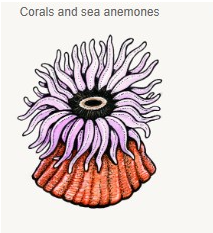
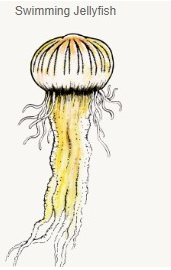
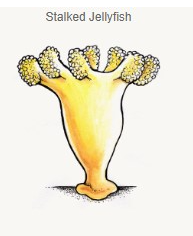
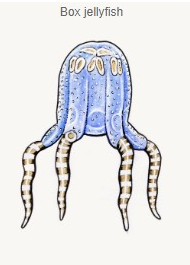
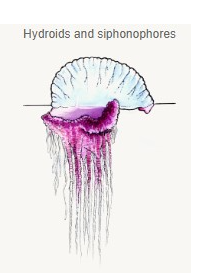
Figure 6: Phylum Cnidaria.
Phylum : Ctenophora
- Books Name
- ACME SMART COACHING Biology Book
- Publication
- ACME SMART PUBLICATION
- Course
- CBSE Class 11
- Subject
- Biology
PHYLUM: CTENOPHORA / SEA WALNUT / COMB JELLIES
Ctenophores are exclusively marine, solitary, free swimming or pelagic, very active animals with transparent and flat or oval body shape and have following important characters :
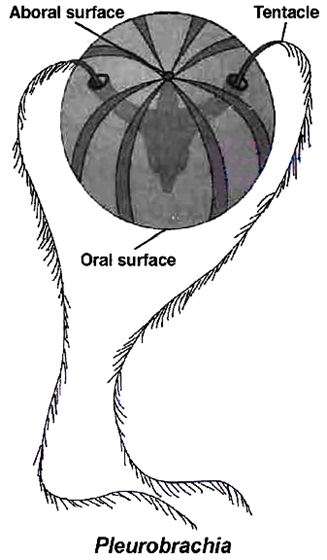
1. Body soft, delicate, transparent and gelatinous without segmentation.
2. Polyp phase is absent in their life cycle, shape is typically spherical, pear shaped or cylindrical, flat in some.
3. They are radially symmetrical, diploblastic, tissue level of organisation and devoid of cnidoblast cells.
4. Tentacles may be present or absent. When present, the number of tentacles is 2. They are solid and possess adhesive cells called colloblasts (lasso cells). Digestion is both extracellular and intracellular. Bioluminescence (the property of a living organism to emit light) is well-marked in ctenophores.
5. The animals move by cilia, which join together to form comb plates. There are eight median combplates forming locomotor organs, hence organisms are called comb-jellies or sea-walnuts.
6. Gastrovascular cavity is branched and opens to the exterior by stomodaeum.
7. They are diploblastic animals but the mesoglea is different from that of cnidaria; it contains amoebocytes and smooth muscle cells and is comparable to a loose layer of cells. From this viewpoint, ctenophores may be considered as triploblastic.
8. Skeletal, circulatory, respiratory and excretory systems are absent. Nervous system is diffuse type.
9. The presence of a special sense organ 'Statocyst' at the opposite end of the mouth (aboral end) is the characteristic of the members of this phylum.
10. All are hermaphrodite. Testes and ovary formed side by side from endoderm of digestive canals.
11. Asexual reproduction doesn't occur. They reproduce only by sexual means. Fertilization is external. Development is indirect and an immature ciliated stage called 'cydippid larva' is found in some forms.
Examples: Hormiphora (The sea walnut), Pleurobrachia (The sea gooseberry), Ctenoplana, Cestum (The venus girdle)
Concept Builder
Word roots and Origins :
(a) Colloblasts from the Greek kolla meaning "glue" and blastos meaning "bud".
(b) Ctenophore from the Greek ktene meaning "comb" and phors meaning "bearing".
Phylum : Ctenophora
Phylum Ctenophora
Ctenophores, often known as sea walnuts or comb jellies, are biradially symmetrical, diploblastic animals with a tissue-level organization that are entirely marine. The body has eight rows of ciliated comb plates on the outside that aid in movement. The existence of comb plates containing cilia, which are employed for propulsion, distinguishes the phylum. Ctenophores have a more complex body than sponges, although it is less complicated than bilaterians. They have tissue-level organization, just like cnidarians. Extracellular and intracellular digestion both are observed. Ctenophores exhibit a lot of bioluminescence (the ability of a living creature to emit light). They do not have stinging cells. In order to capture prey, ctenophores possess sticky cells called Colloblasts. The sexes are not divided. Sexual reproduction is the only way to reproduce.
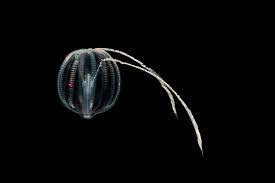
External fertilization is used in conjunction with indirect development.Examples arePleurobrachia and Ctenoplana.
Phylum: Platyhelminthes
- Books Name
- ACME SMART COACHING Biology Book
- Publication
- ACME SMART PUBLICATION
- Course
- CBSE Class 11
- Subject
- Biology
PHYLUM : PLATYHELMINTHES (Flatworms)
Phylum Platyhelminthes contains about 13,000 species, mostly parasites that live in other animals including man.
The important characters of this phylum are:
1. The flat worms are mostly parasites but some are free living e.g., Planaria.
2. They are acoelomate, triploblastic, bilaterally symmetrical and dorsoventrally flattened animals.
3. They have organ system level of organisation.
4. Body is not segmented except in class Cestoda (false segmentation).
5. Body is covered with a cellular, syncytial, one layered, partly ciliated epidermis; while in parasitic trematodes and cestodes, epidermis is lacking and the body is covered with cuticle.
6. Exoskeleton and Endoskeleton are completely absent. However hooks, spines, suckers (in parasitic form), teeth or thorns may be present which act as adhesive organs.
7. The space between the body wall, alimentary canal and other organs is filled with a peculiar connective tissue called the parenchyma. It helps in transportation of food materials.
8. Digestive system is totally absent in tapeworms, so they absorb food directly through body surface. In Trematoda and Turbellaria, it consists of mouth, pharynx and blind intestine (anus absent).
9. Respiratory and circulatory systems are absent.
10. Excretory system consists of single or paired protonephridium with flame cells.
11. Nervous system is primitive. The main nervous system consists of a pair of cerebral ganglia or brain and one to three pairs of longitudinal nerve cords connected to each other by transverse commissures. This type of nervous system is called ladder like nervous system e.g., Planaria (Ougesia).
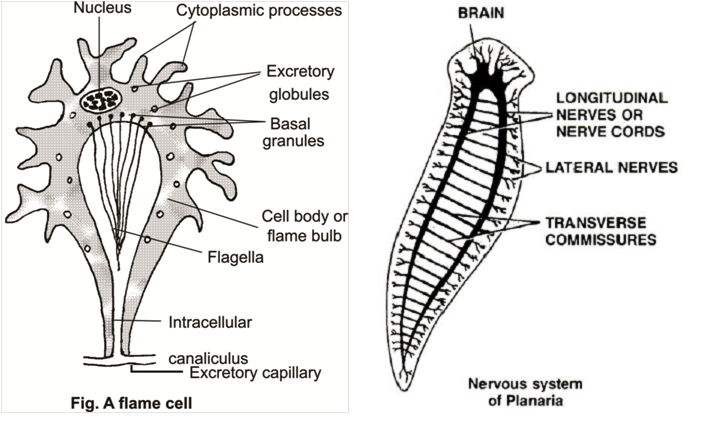
12. Sense organs are of common occurrence in Turbellaria but these are greatly reduced in parasitic forms.
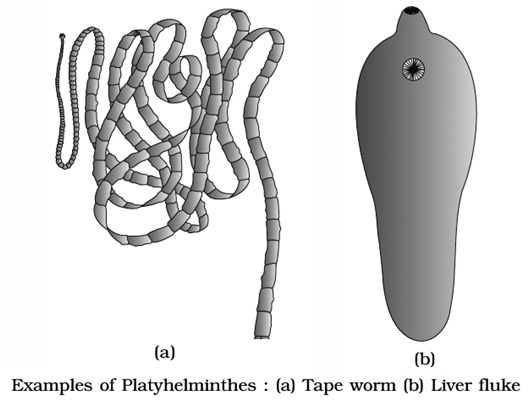
13. Sexes are united, i.e., hermaphrodite with very few exceptions like Schistosoma (Blood fluke).
14. Asexual reproduction by fission occurs in many fresh water forms like Turbellarians.
15. In majority of forms, eggs are devoid of yolk but provided with special yolk cells and are covered by egg shell.
16. Cross fertilization in trematodes and turbelleria and self-fertilization in cestodes is very common. Fertilization is internal. Development indirect with many larval stages.
17. Life cycle complicated, involves one or more hosts.
18. Regeneration. It is well marked in some flat worms like Planaria.
CLASSIFICATION
- Phylum platyhelminthes is divided into three classes.

Phylum: Platyhelminthes
Phylum Platyhelminthes
Flatworms and tapeworms are popular names for Platyhelminthes. They are a type of invertebrate with a soft body. In reality, there are over 20,000 different species of these animals. A few of these parasites live on humans and other animals as parasites. Furthermore, because of their parasitic nature, they do cause some discomfort to the host animal. Schistosomiasis, often known asbilharziasis, is a parasitic flatworm disease. A few species in this phylum are known to be major causes of disease. They are triploblastic, acoelomate, and bilaterally symmetrical. Their body is dorsoventrally flattened which is its most noticeable feature. They are flat because the body has no cavities. They also lack specialized systems and do not have segmented bodies. They have no specialized circulatory and respiratory organs, which allows oxygen and nutrients to pass through their bodies by diffusion.Around 80% of the flatworms are parasitic, with a few free-form flatworms thrown in for good measure. Scavengers or predators are the free-living forms. The parasitic species feed on the tissues of the organism they dwell in. Planaria, for example, has a high potential for regeneration. This phylum's animals come in a wide range of sizes. Some are minuscule, while others can reach lengths of up to two feet. They're also hermaphrodites, which means they have both sexes living in the same body.They typically reproduce both sexually and asexually. For instance, Taenia (Tapeworm) and Fasciola (Liver fluke).
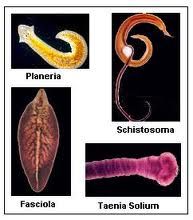
Phylum: Aschelminthes / Nemathelminthes
- Books Name
- ACME SMART COACHING Biology Book
- Publication
- ACME SMART PUBLICATION
- Course
- CBSE Class 11
- Subject
- Biology
PHYLUM: NEMATHELMINTHES OR ASCHELMINTHES
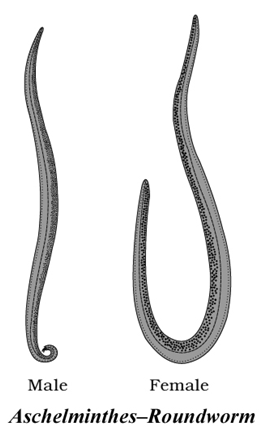
The phylum includes bilaterally symmetrical, triploblastic, pseudocoelomate animals with organ system grade of organisation. They are circular in cross-section.
They are free living, aquatic or terrestrial or parasitic (on plants or animals).
Excretory system involves an excretory cell (a large giant H-shaped cell) called Renette cell (multinucleated).
They have tube-within tube type of body plan evolved along Protostomic evolutionary line.
Sexes separate, show sexual dimorphism, fertilisation internal, development direct or indirect.
CLASSIFICATION
On the basis of caudal receptor or phasmids, Aschelminthes can be divided into 2 classes-
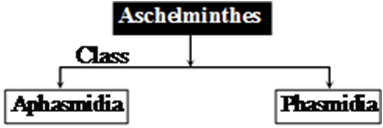

Important classes of this phylum are:
Class : Nematoda.
Examples: Ascaris, Wuchereria, Enterobius, Trichuris. Rhabditis is a free living roundworm.
Class : Rotifera.
Examples: Wheel worms
Phylum: Aschelminthes / Nemathelminthes
Phylum Aschelminthes
Roundworms are the popular name for Aschelminthes. They are triploblastic, bilaterally symmetrical, and pseudocoelomates creatures. Aschelminthes can be parasitic or free-living. The free-living creatures, which feed on bacteria, are abundant in soils and sediments. Others are plant parasites that can cause disease in economically significant crops. The remaining parasites can be found in both animals and humans. Hookworms, pinworms (Enterobius), Guinea worms (Dracunculus), and intestinal roundworms are examples of parasitic worms. A well-developed muscular pharynx completes the alimentary canal. Through the excretory hole, an excretory tube transfers body wastes from the body cavity. In most of the Aschelminthes, the respiratory and circulatory systems are absent. They utilize the process of diffusion for the circulation of oxygen. Aschelminthes are dioecious, which means they are separate. Females are frequently taller than males.Internal fertilization occurs, and development can be either direct (the young resemble the adult) or indirect. The Giant Intestinal Roundworm (Ascaris lumbricoides) is an endoparasite that lives in the human gut. They're quite prevalent in kids. Ascariasis is a disease caused by these worms. Many adult roundworms dwell inside the intestine, obstructing the digestive tract.Examples: Ascaris (Roundworm), Wuchereria (Filaria worm), Ancylostoma (Hookworm).

Phylum : Annelida
- Books Name
- ACME SMART COACHING Biology Book
- Publication
- ACME SMART PUBLICATION
- Course
- CBSE Class 11
- Subject
- Biology
PHYLUM : ANNELIDA
- The phylum includes over 9,000 species of metamerically segmented animals with a true coelom called the Schizocoelom.
General characters of Phylum Annelida
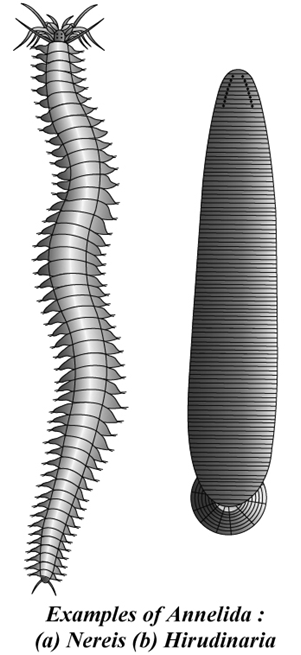
1. The organisms are triploblastic, bilaterally symmetrical, coelomates with organ system level of body organization and are metamerically segmented.
2. Body wall has an epidermis of columnar epithelium coated externally by moist albuminous cuticle and with circular and longitudinal muscle fibres.
3. Chitinous setae, aiding in locomotion, mayor may not be present on fleshy parapodia; absent in leech.
4. Annelids are the first animals to have a true schizocoelic coelom. Coelom is divided by septa into compartments.
5. The coelomic fluid act as a hydrostatic skeleton.
6. Digestive system is complete and digestion is extracellular.
7. Respiration by moist skin (cutaneous respiration) or through gills (Branchial respiration).
8. Blood vascular system is usually closed. Respiratory pigments, either haemoglobin or erythrocruorin, are dissolved in blood plasma. Free amoeboid blood corpuscles are present, butthere are no RBCs. ln leech, there is no true blood vascular system.
9. Nephridia are the excretory organs. Ammonia is chief excretory waste.
10. The nervous system consists of a nerve ring and asolid, double, mid-ventral nerve cord with ganglia and lateral nerves in each segment.
11. Sensory organs include tactile organs, taste buds, statocysts, photoreceptor cells and eyes with lenses.
12. The sexes may be separate (e.g., Nereis) or united (e.g., earthworm, leech).
13. Development is mostly direct (e.g., Earthworm). There is indirect development in Nereis. Larva, when present is trochophore.
CLASSIFICATION OF ANNELIDA
Based on presence or absence/of Parapodia, Setae and Sense organs

NEREIS
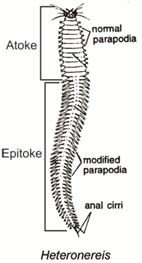
Inhabits in sea - shore between tide mark, burrower, nocturnal, carnivorous, gregarious, fertilization - in sea.
Parapodia in each segment except first & last. During breeding body divides in two parts. Anterior asexual part - Atoke and posterior sexual portion Epitoke. This change is known as epitoky.
Phylum : Annelida
Phylum Annelida
Phylum Annelida contains around 17000 species. Ringworms and segmented worms are other names for annelids. They can be found in a variety of habitats, including coastal waterways, freshwater, and wet terrestrial places. The annelids can be as small as a few centimeters long or as large as three meters. In addition, some species in this phylum have unusual forms and vibrant colors. Annelids are invertebrate creatures with bilateral symmetry. They are triploblastic and coelomate. Their body surface is divided by segments called metameres. They have longitudinal and circular muscles that let them move around. Nereis and other aquatic annelids have lateral appendages called parapodia that aid in swimming.There is a closed circulatory system in place. Osmoregulation and excretion are aided by nephridia (sing. nephridium). The neural system is made up of paired ganglia (sing. ganglion) coupled to a double ventral nerve cord via lateral nerves. Earthworms and leeches are monoecious, but Nereis, an aquatic variety, is dioecious. Sexual reproduction is prevalent. Nereis,Pheretima (Earthworm), and Hirudinaria are other examples (Bloodsucking leech).
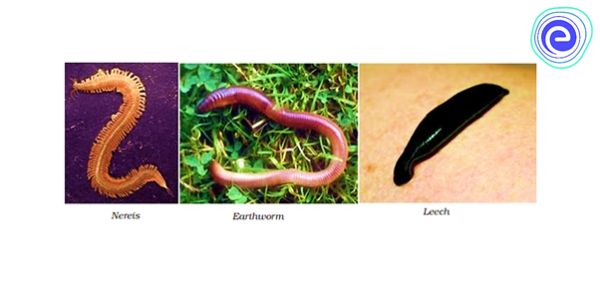
Phylum : Arthropoda
- Books Name
- ACME SMART COACHING Biology Book
- Publication
- ACME SMART PUBLICATION
- Course
- CBSE Class 11
- Subject
- Biology
PHYLUM . ARTHROPODA
- It is the largest phylum in the animal kingdom, including 900,000 species. The largest class is insecta with 750,000 species.
- General chacters are :
1. They are triploblastic, coelomate and bilaterally symmetrical animals. The body cavity is full of haemolymph (blood) and it's known as haemocoel. The true coelom is restricted to gonads.
2. The body is covered by chitinous cuticle, which forms the exoskeleton which is shed at intervals i.e., undergo moulting/ecdysis.
3. They have a segmented body, each segment bearing a pair of jointed appendages covered by a jointed exoskeleton. Chitinous exoskeleton is secreted by the underlying epidermis.
4. The body is divided into head, thorax and abdomen. In some cases, the head and thorax is fused to form cephalothorax. In insects, the thoracic segments have legs and wings, the abdomen has no legs in insects.
5. Respiratory organs are gills, book gills, book lungs or tracheal system.
6. Excretion takes place through green glands or malpighian tubules since nephridia are absent.
7. Sensory structures in arthropods are antennae for perceiving odour, eyes, statocysts or balance organs and sound receptors (in chirping crickets and cicadas). Eyes are simple or compound. In honey bees, butterflies, moths and some other insects, the gustatory receptors are present on their feet.
8. The heart is dorsal and circulatory system is open.
9. The central nervous system consists of paired pre-oral ganglia connected by commissures to a solid double ventral nerve cord.
10. In land arthropods, the fertilization is always internal.
11. Arthropods are mostly dioecious, oviparous. In some like the scorpion, the eggs hatch within the female body. They bring forth the young ones alive. They are viviparous. Development is direct or indirect.
Advancement Over Annelida
1. Distinct-head in all species.
2. Jointed appendages serving a variety of functions.
3. Jointed exoskeleton for protection and muscle attachment.
4. Striped muscles arranged in bundles for moving particular body parts.
5. Special respiratory organs such as gills, trachea, book lungs in majority of cases.
6. Well developed sense organs such as compound eyes, statocysts, auditory organs, taste receptors etc.
7. Endocrine glands and pheromone secretion for communication.
CLASSIFICATION
- The phylum arthropoda is divided into five classes.
Class 1. Crustacea
(i) The body is divisible into cephalothorax (head + thorax) and abdomen.
(ii) Dorsally, the cephalothorax is covered by a thick exoskeletal carapace.
(iii) There are present two pairs ofantennae and a pair ofstalked compound eyes and biramous appendages.
(iv) Respiration is carried out either by body surface or by giliis.
(v) Excretion takes place usually by antennary glands (green glands).
(vi) Sexes are usually separate. Sexual dimorphism is also seen.
(vii) Development is usually indirect.
Examples: Palaemon (Prawn), Macrobrachium (Prawn), Astacus (Crayfish), Palinurus (Lobster), Cancer(Crab), Lucifer(Shrimp), Eupagurus (Hermit Crab), Oniscus (Wood louse, terrestrial), Oaphnia (Water-flea), Cyclops, Balanus (barnacle). Tiny crustaceans such as Oaphnia and Cyclops act as zooplanktons which form important link in the food chain in water.
Class 2. Chilopoda
(i) Body is long, segmented and divisible into head and trunk.
(ii) Each trunk segment bears a pair of legs. The first pair of legs are modified into poison claws.
(iii) There is a single pair of antennae and ocelli.
(iv) Many legs are present.
(v) Respiration occurs by tracheae.
(vi) Excretion takes place by Malpighian tubules.
(vii) Development is direct
Examples: Scolopendra (Centipede).
Class 3. Diplopoda
(i) Body is divisible into head, thorax and abdomen.
(ii) There is a single pair of antennae and ocelli.
(iii) Except first thoracic segment, (if does not have legs) each thoracic segment bears a pair of legs, however each abdominal segment has two pairs of legs.
(iv) Respiration occurs by tracheae.
(v) Excretion takes place by Malpighian tubules.
(vi) Development is generally direct e.g., Julus (Millipede).

Class 4. Insecta (Hexapoda) [Largest number of species]
(i) Body is divisible into head, thorax and abdomen.
(ii) There is a pair of antennae and a pair of compound eyes.
(iii) The thorax consists of three segments with three pairs of legs and usually two pairs of wings. For example, mesothoracic wings which are thick and leathery are called tegmina and metathoracic wings are membranous (in cockroach). Wings may be absent in same insects.
(iv) The abdomen may consists of ten segments.
(v) Respiration usually takes place by tracheae. (No respiratory pigments).
(vi) Heart is tubular and divided into chambers.
(vii) Malpighian tubules are the excretory organs. Uric acid is chief excretory waste. (viii) Sexes are separate.
(ix) Development may be direct or indirect e.g., silver fish, cockroach, bedbug, locust, termites, butter flies, rat flea, beetle, wasp, aphid, glow worm etc. Maggot is the larva of Housefly.
- Insects communicate with each other by ectohormones called Pheromones. Pheromones are chemicals secreted outside the body and perceived (as smell by other individuals of same species). They help in communication amongst the organisms of the same species.

Class 5. Arachnida
(i) The body is usually divisible into cephalothorax and abdomen.
(ii) The cephalothorax bears simple eyes and six pairs of appendages (one pair of chelicerae, one pair of pedipalpi and four pairs of legs).
(iii) Antennae are absent.
(iv) Respiratory organs are book lungs or tracheae or both.
(v) Excretion takes place by Malpighian tubules or coxal glands or both.
(vi) Development is generally direct.
Examples: Tick, Mite, Aranaeus (garden spider), Palamneus (Scorpion), Buthus (Scorpion).
(vii) Spiders spin the web by means of proteinaceous secretions of abdominal glands known as "spinnerets".
- There are two more classes in the phylum Arthropoda. These classes are Onychophora and Merostomata. Peripatus is an important example of the class onychophora which has characters of phylum Annelida and Arthropoda.
- Hence it is called "connecting link". Umulus, (the king crab or Horseshoe crab) is an example of class Merostomata which respires with book gills.
- The king crab is called "living fossil". A living fossil is a living animal of ancient origin with many primitive characters.
Concept Builder
1. Peripatus is considered as connecting link between annelida and arthropoda as it has unjointed legs and breathes by trachea.
2. Larvae of different Arthropods
(a) Bombyx(Silkworm) Caterpillar/Silkworm.
(b) Beetles, honey bee Grub
(c) Musca (Housefly) Maggot
(d) Culex, Anopheles Wriggler
(e) Pennaeus(marine prawn) Mysis, nauplius, protozoea
(f) Cancer(Crab) Megalopa, metanauplius, zoea
3. Terga are dorsal plates whereas sterna are ventral plates of exoskeleton.
4. Arthrodial membranes join the different sclerites.
5. Halters are drumstick shaped, second pair of reduced wings of housefly and mosquito which helps in balancing.
6. Eggs of Culex are cigar shaped; they are laid vertically on the surface of water in clusters; airfloats are absent; whereas in Anopheles eggs are boat shaped, laid singly and horizontally; they have airfloat.
7. Larva of Culex is bottom feeder whereas larva of Anopheles is surface feeder.
8. Adult of Culex lies parallel to the surface and both ends of body deflexed whereas in Anopheles, the body is inclined at an angle of 45° to the surface. So, they can be distinguished with the help of sitting posture.
9. In Spider, Spinnerets are present anterior to the terminal anus. They produce silken thread.
10. Von Frisch described the process of communication of food source in honey bees.
11. Insecticides sprayed over the mosquitoes desensitize their nervous system as well as chemoreceptors and mechanoreceptors ofthe antennae.
12. Johnston's organs are present on antennae of mosquitoes.
13. The life cycle is generally accompanied with metamorphosis. Larvae and adults may show different feeding habits and occupy different habitats.
14. Insects like bees, wasps, beetles, moths and butterflies are good pollinators for important crops.
15. Ants, termites and locusts are eaten by Chinese and Indians; Eggs of aquatic bugs are used as food by Mexicans; Ox-warbles are eaten by Red Indians.
16. Dragon flies feed on the larvae of mosquitoes
17. Glow worm (Firefly) shows bioluminescence.
18. Adult Culex and Anopheles can be distinguished with the help of Sitting posture.
19. The insects may be divided into five groups on the basis of their mode of development.
1. Ametabola insects – metamorphosis absent. The young ones resemble adult.
![]()
ex. Lepisma (Silver fish)
2. Paurometabola insects – gradual metamorphosis
![]()
- ex. Cockroach, Grasshopper, Locusts etc.
3. Hemimetabola insects – incomplete metamorphosis. Habitat of young ones is different from adults.

ex. Dragon flies (Naiads aquatic but adults aerial)
4. Holometabola insects – complete metamorphosis
![]()
ex. House flies, Butterflies, Mosquitoes etc
5. Hypermetabola insects – various forms of larvae

ex. Blister beetle.
Phylum : Arthropoda
Phylum Arthropoda
Arthropods are animals with joint legs. Spiders, ants, bees, crabs, shrimps, millipedes, centipedes, and other insects belong to this phylum of the kingdom Animalia. Arthropods make up more than two-thirds of all identified species on the planet. The presence of an exoskeleton, which makes arthropods adaptable, isprotective and allows flexibility and mobility.It is largely responsible for their success and survival. They are organized at the organ-system level. They are coelomate animals that are triploblastic, segmented, and bilaterally symmetrical. Arthropods have a chitinous exoskeleton covering their bodies. The head, thorax, and abdomen make up the arthropod body. Their appendages are joined. Gills, book gills, book lungs, and the tracheal system are examples of respiratory organs.The circulatory system is open. There are sensory organs like antennae, eyes (complex and simple), and statocysts for balance and orientation. Malpighian tubules are used for excretion. The majority of them are dioecious. Internal fertilization is common. The majority of them are oviparous. Direct or indirect development is possible. Apis (Honey bee), Bombyx (Silkworm), and Laccifer(Lac insect)are some examples of commercially important insects. Anopheles, Culex, and Aedes are examples of vectors (Mosquitoes). Limulus (King crab) is known as a living fossil, while Locusta(Locust) is a gregarious pest.
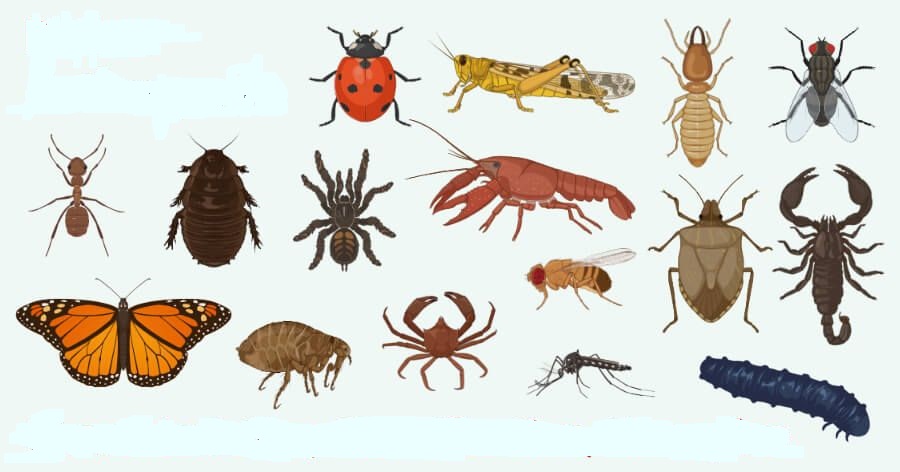
Phylum : Mollusca
- Books Name
- ACME SMART COACHING Biology Book
- Publication
- ACME SMART PUBLICATION
- Course
- CBSE Class 11
- Subject
- Biology
PHYLUM MOLLUSCA
Phylum mollusca is the second largest phylum in animal kingdom which includes over 60,000 species. General characters are :
- Molluscs are terrestrial, aquatic (fresh water or marine) triploblastic, bilaterally symmetrical, schizocoelic and unsegmented animals.
- Most molluscs secrete a shell of calcium carbonate that protects and supports their soft tissues.
- The body is organised into three general regions: head, foot and visceral hump.
- The visceral hump contains the digestive tract and other visceral organs.
- The body is covered by a soft and spongy skin fold called mantle which secretes the shell.
- The space between the hump and the mantle is called mantle cavity in which feather like gills are present.
- Molluscs typically employ a feeding organ called radula which is armed with rows of chitinous teeth. The radula is protruded from the mouth and worked back and forth to rasp the food into fine particles.
- Circulatory system is mainly of open type but some reduced sinuses are present. Respiratory pigment is haemocyanin.
- Respiration occurs by feather like gills, pulmonary sac or both, or through general body surface.
- Excretion occurs by paired Organ of Bojanus. Another excretory organ called Keber's organ (Pericardial gland) is also present in Unioalongwith paired organ of Bojanus. It pours the waste into pericardium from where the waste is carried to the organ of Bojanus that opens out through mantle cavity.
- Sense organs include eyes, statocysts and osphradia (chemoreceptor to test chemical nature of water).
- Reproduction sexual, adults can be dioecious (unisexual) or monoecious (bisexual or hermaphrodite) Fertilization is generally external, development is direct or through free larval forms like trochophore, veliger (in Pila), glochidium (in Unio) -an ectoparasite on fishes.
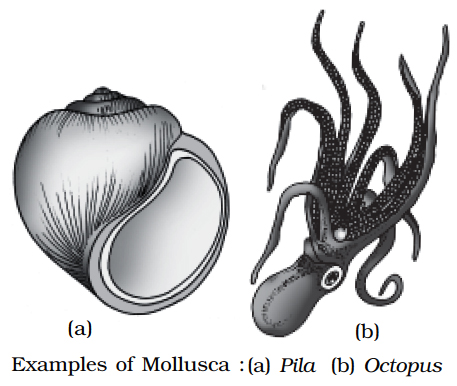
Pila produces 2 types of sperms :
(i) Eupyrene -Motile and functional sperms, 25 µm long, thread like with a single cilium.
(ii) Oligopyrene -Non-motile and non-functional sperms, 32.5 µm long, spindle shaped with 4-5 cilia.
CLASSIFICATION
Molluscs' classification is mainly on the basis of shell and foot.

Concept Builder
(i) Architeuthis (Giant AtJantic squid) is the largest and heaviest among invertebrates, 55 feet length.
(ii) Nautilus is the only cephalopod with external shell, so ink glands are absent.
(iii) The colour change in cephalopods occurs due to chromatophores.
Phylum : Mollusca
Phylum Mollusca
Molluscs are a diverse group of organisms that play a vital role in the global ecology. A calciferous shell is found on many creatures in this phylum. The bodies are usually soft and protected by a hard exoskeleton. They can be found both on land and in the deepest parts of the ocean. This is the second-largest phylum of animals. Molluscs are organ-system-organized terrestrial or aquatic (marine or freshwater) animals. They are animals that are bilaterally symmetrical, triploblastic, and coelomate. A calcareous shell covers the body, which is unsegmented with a distinct head, muscular foot, and visceral hump. Over the visceral hump, a soft and spongy layer of skin forms a mantle.The mantle cavity is the region between the hump and the mantle, and it contains feather-like gills. They have breathing and excretory systems. Sensory tentacles can be found in the anterior head region. The radula, a file-like rasping organ in the mouth, is used for feeding. They are both a food and a jewellery source. The firm shells are used to create stunning jewellery. Even though it sounds strange, these are also raised as pets in some parts of the world. Bivalve and gastropod pearls are particularly valuable because they are lined with nacre. Natural pearls are generated when a small foreign object becomes lodged between the mollusc's mantle and shell.Bivalve molluscs are useful as freshwater and marine bioindicators. However, not all molluscs are beneficial to humans. Snails and slugs, for example, are considered pests.They are usually dioecious and oviparous with indirect development. Examples: Pila (Apple snail), Pinctada (Pearl oyster), Sepia (Cuttlefish), Loligo (Squid), Octopus (Devilfish), Aplysia (Seahare), Dentalium (Tusk shell), and Chaetopleura (Chiton).
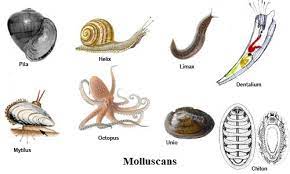
Phylum : Echinodermata
- Books Name
- ACME SMART COACHING Biology Book
- Publication
- ACME SMART PUBLICATION
- Course
- CBSE Class 11
- Subject
- Biology
10. PHYLUM: ECHINODERMATA
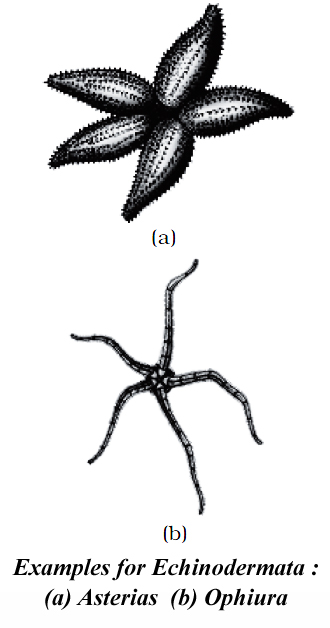
They are exclusively present in marine water and there are no parasitic forms. Similarities with chordates :
(i) They have tube within tube type of body plan which has evolved along deuterostomic evolutionary line.
(ii) They possess a true coelom called enterocoelom.
(iii) They have mesodermal skeleton made of calcareous plates or ossicles.
All these characters make the echinoderms closer to chordates. The other characters are :
1. The symmetry is bilateral in larvae but pentamerous radial in adults.
2. Many echinoderms bear a number of calcareous spines on their body surfaces called tubercles. Between the spines, there are pincer like structures called pedicellariae to keep the surface clean. Pedicellariae are made of three calcareous plates. Two calcareous valve like structures in the form of jaws resting upon a basal calcareous plate.
3. Between the spines, there are finger like processes called dermal branchiae which help in respiration.
4. Mouth is on ventral/oral side and aniss is on dorsal or aboral side.
5. There is no distinct anterior and posterior end i.e., no cephalisation.
6. Haemal and Perihaemal Systems: Instead of blood vascular system, there are present haemal and perihaemal systems which are of coelomic origin. Thus the so called circulatory system is open type. The so called blood is often without a respiratory pigment. There is no heart.
7. Respiratory Organs : Gaseous exchange occurs by dermal branchiae or papulae in star fishes, peristominal gills in sea urchins, genital bursae in brittle stars and cloacal respiratory trees in holothurians. Exchange of gases also takes place through tube feet.
8. Excretory organs : Specialized excretory organs are absent. Nitrogenous wastes are diffused out via gills or dermal branchiae. Ammonia is chief excretory matter.
9. Sexes are separate. Reproduction is sexual. Fertilization is usually external. Development is indirect with free-swimming larva.
CLASSIFICATION
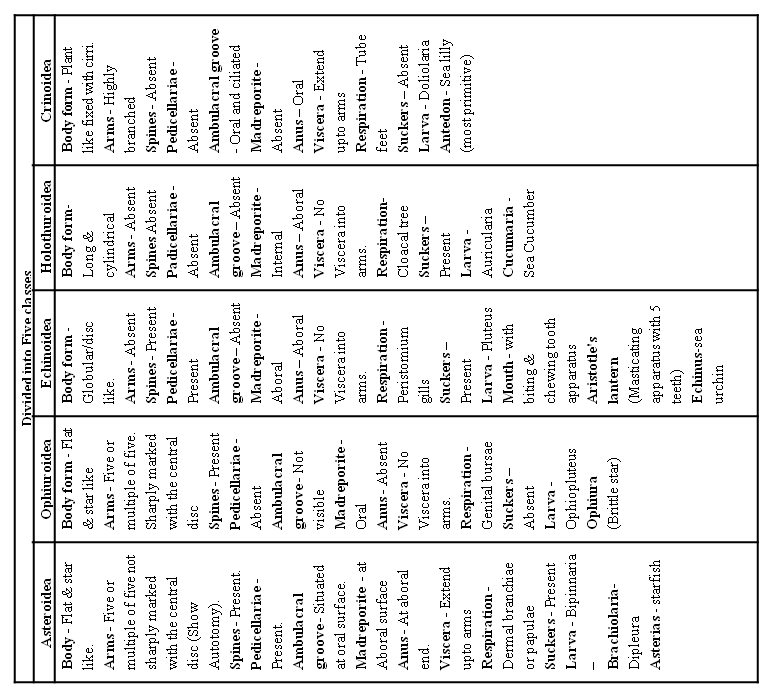
Concept Builder
1. The starfish uses the suction cup-like ends of the tube feet of one arm to hold on to rocks, as it moves the other arms. It can open bivalves (molluscs) by attaching two arms to either sides of a bivalve and pulling them apart. The bivalve opens out, the stomach of starfish is then everted through its mouth and introduced into the open mollusc which is partly digested before being ingested. Echinoderms predate on coral polyps also.
2. Word roots and origin : ampulla from Latin meaning ''flask''.
Phylum : Echinodermata
Phylum Echinodermata
Invertebrates with spiny skin are known as echinoderms. The endoskeleton of these creatures is made up of calcareous ossicles. All of them are marine, having organ-system organization. There are no freshwater or terrestrial organisms in this phylum. Adult echinoderms have radial symmetry, whereas larvae have bilateral symmetry. They are coelomate and triploblastic creatures. With the mouth on the bottom (ventral) side and the anus on the upper (dorsal) side, the digestive system is complete. Echinoderms are distinguished by the presence of a water vascular system that aids motility, food capture and transport, and breathing. This system has a central ring canal and radial canals that extend along each arm. Through these structures, water circulates. The madreporite is a structure present on top of the body. This is responsible for the regulation of the water in the water vascular system. There is no excretory system. Sexes are distinct. Reproduce sexually. External fertilization is common. The development of free-swimming larva is indirect. Asterias (starfish), Echinus (sea urchin), Antedon (sea lily), Cucumaria (sea cucumber), and Ophiura (Brittle star) are among examples.
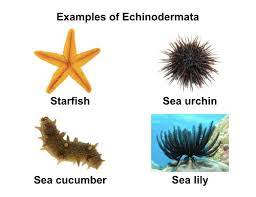
Phylum : Hemichordata / Stomachordata
- Books Name
- ACME SMART COACHING Biology Book
- Publication
- ACME SMART PUBLICATION
- Course
- CBSE Class 11
- Subject
- Biology
PHYLUM: HEMICHORDATA / STOMOCHORDATA
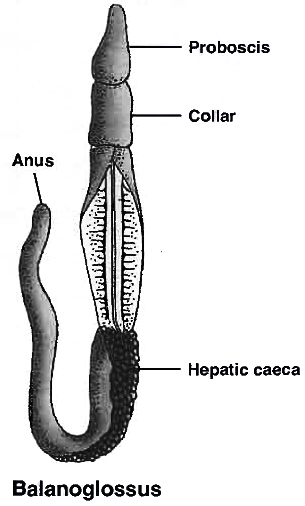
Hemichordata was earlier considered as a sub-phylum under chordata. But now it is placed as a separate phylum under non-chordata.
The phylum consists of a small group of worms like marine animals with organ system level of organisation.
Its characteristics are :
(i) In hemichordata or stomochordata, true notochord is absent. gill slits are present but they are dorso lateral in position. They are worm like. bilaterally symmetrical. triploblastic and entero-coelomate animals.
(ii) Stomochord is a hollow outgrowth arising from the roof of the buccal cavity, also called 'buccal diverticulum'. It is present in the proboscis.
(iii) Dorsal heart, ventral hollow nerve cord, no respiratory pigments. Circulatory system is open. Respiration by gills.
(iv) Development is mostly indirect through a free swimming tornaria larva. e.g. Balanoglossus (acorn, tongue worm), Glossobalanus. Sexes are separate. Fertilization is external.
(v) Believed to be connecting link between non-chordates and chordates.
(vi) Due to the absence of true notochord in hemichordata, many taxonomists do not consider these animals as chordates.
(vii) Excretory organ is proboscis gland.
(viii) The body is cylindrical and is composed of an anterior proboscis, a collar and a long trunk.
Examples : Balanoglossus, Saccoglossus
Phylum : Hemichordata / Stomachordata
Phylum Hemichordata
This phylum is made up of marine deuterostome creatures. They are sometimes referred to as the Echinodermata's sister group. Phylum Hemichordata is a small phylum with only 100 recognized species and animals that resemble worms. Some species live alone, while others live in colonies. Hemichordata was previously classified as a sub-phylum of the Chordata phylum. However, because these species lack a post-anal tail or even the notochord, which is a distinguishing trait of chordates, they are now classified as a different phylum under non-Chordata.
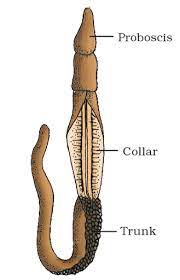
Hemichordates, on the other hand, have a primitive structure comparable to the notochord in the collar region. This phylum is made up of a tiny group of worm-like marine organisms that are organized at the organ-system level.This phylum is made up of marine deuterostome creatures. They are sometimes referred to as the Echinodermata's sister group. Hemichordatesare bilaterally symmetrical and triploblastic animals.The body is divisible into proboscis, collar, and trunk.Simple, open, and well-developed circulatory system is present. The alimentary canal is a straight, complete, or U-shaped tube.Excretion by a single glomerulus situated in the proboscis.Reproduction is mainly sexual. Sexes are usually separate.External fertilization takes place in seawater.Development can be direct or indirect.An important example of a hemichordate is Balanoglossus or acorn worm. Other species are Saccoglossus, Rhabdopleura, Atubaria, and Dendrograptus.
phylum chordata
- Books Name
- ACME SMART COACHING Biology Book
- Publication
- ACME SMART PUBLICATION
- Course
- CBSE Class 11
- Subject
- Biology
PHYLUM: CHORDATA
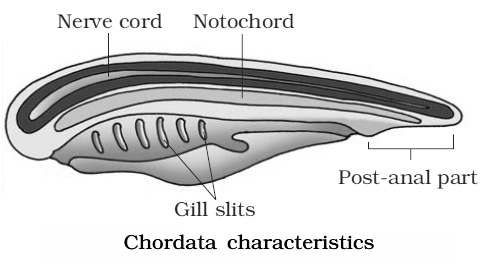
The most important characteristics of phylum chordata are:
1. They possess a notochord either throughout life or during early embryonic development.
2. Dorsal hollow nerve cord.
3. Paired gill slits on the lateral sides of pharynx.
4. Post anal tail.
5. Closed circulatory system.
Phylum chordata can also be divided as :
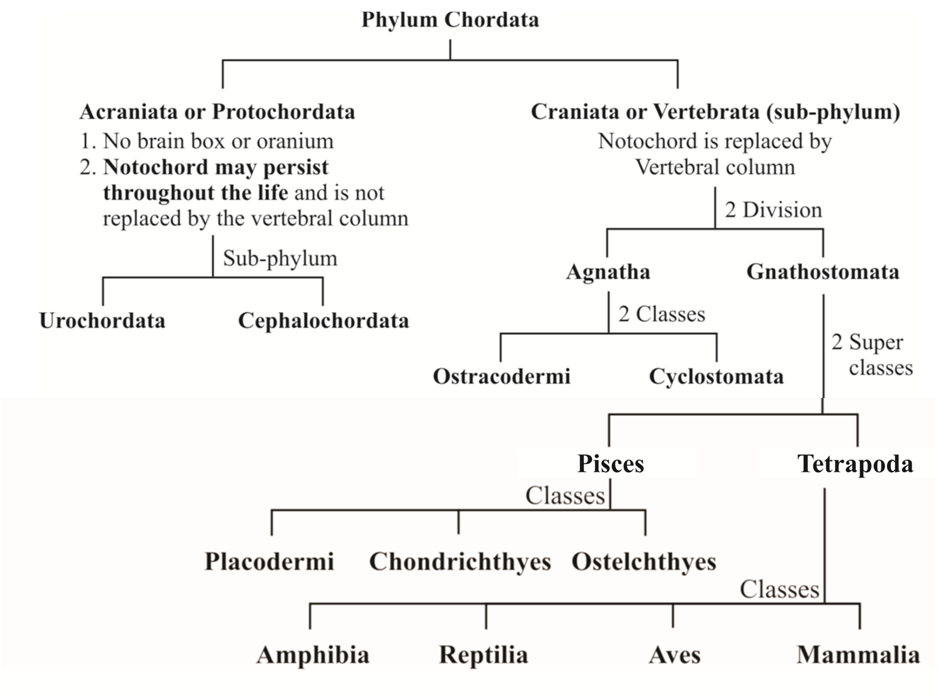
CLASSIFICATION OF PROTOCHORDATA OR ACRANIATES
Sub-Phylum 1. Urochordata
They are exclusively marine.
(i) This sub-phylum is also called Tunicata because the adult body is enclosed within a leathery test or tunic formed of a cellulose-like organic substance termed tunicin.
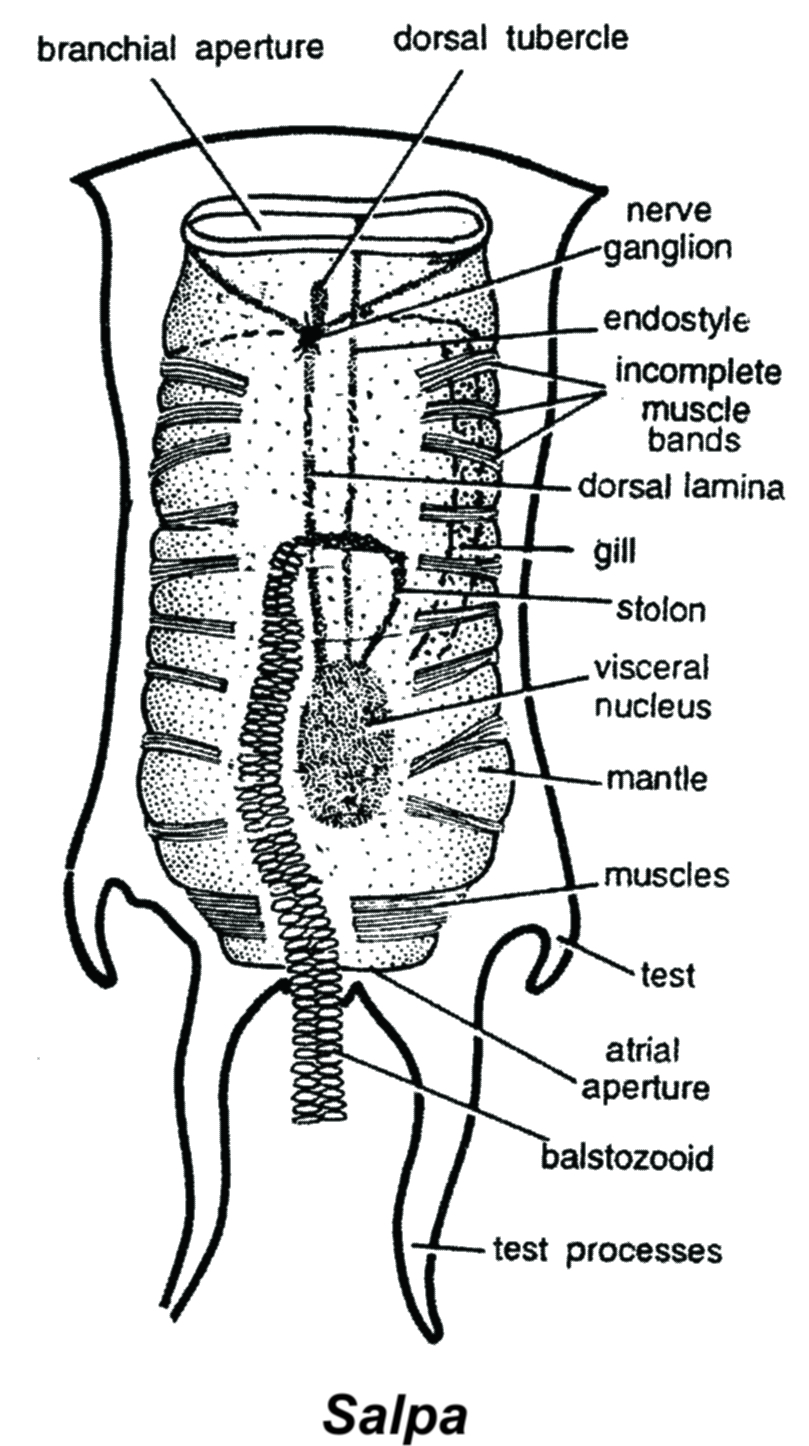
(ii) The larva (Ascidian tadpole) undergoes retrogressive metamorphosis, i.e., change from better developed larva to less developed adult, e.g., Herdmania (Sea Squirt).
(iii) Vanadocytes are present except in Herdmania. Vanadium gives green colour to blood. Excretion by neural gland, hence excretion is glandular.
Examples: Salpa, Doliolum, Ascidia.
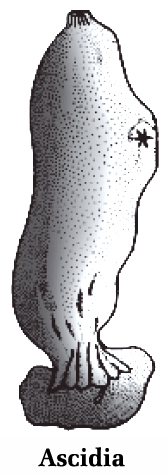
Sub-phylum 2. Cephalochordata
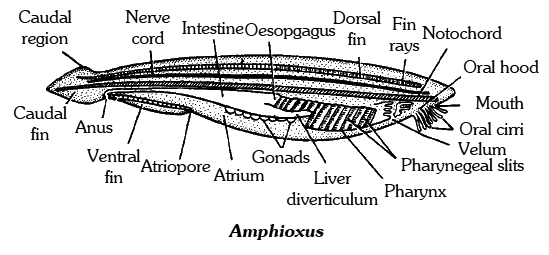
(i) The notochord extends upto anterior end of the body, hence this sub-phylum is named so.
(ii) The tail is present throughout life,e.g., Branchiostoma (Amphioxus).
Amphioxus / Branchiostoma has both ends pointed like lance. Hence it is commonly called lancelet.
VERTEBRATA OR CRANIATA
(i) These are advanced chordates that have cranium (cartilage or bony brain box) around brain.
(ii) Notochord is present only in the embryonic stages, it is replaced by cartilaginous or bony vertebral column (back bone) in the adult forms. They have paired appendages as fins and limbs.
(iii) Closed circulatory system, muscular and ventral heart 2, 3 or 4 chambered, lymphatic system present, erythrocytes and haemoglobin are present.
(iv) A pair of kidneys are present for excretion and osmoregulation; endocrine glands are well developed; they are generally unisexual; have single pair of gonads.
Division 1 : Agnatha (The Jawless Vertebrates)
They are the most primitive of all craniates.
The mouth does not possess jaws hence named Agnatha.
Vertebral column is represented only by small imperfect neural arches over the notochord.
They do not have exoskeleton and paired appendages.
They have single nostril. Internal ear has one or two semi-circular canals.
They are cold blooded.
It includes 2 classes :
1. Ostracodermi 2. Cyclostomata
1. Ostracodermi:
Ostracodermi are all extinct now and are called fossil agnatha.
These were shell skinned with exoskeleton of bony plates. e.g. Cephalaspis.
They were the first jawless fishes (originated in Ordovician period in Palaeozoic era).
2. Cyclostomata: Its general characters are :
(i) All living members of the class Cyclostomata are ectoparasites on some fishes. The body is devoid of scales and paired fins. Head and brain are poorly developed. They are also called jawless fishes.
(ii) Cyclostomes have an elongated body bearing 6 -15 pairs of gill slits in their gill pouch for respiration and have a sucking and circular mouth .
(iii) Single sex organ discharges the gametes in the well developed coelom.
(iv) Cranium and vertebral column are cartilaginous with persistent notochord.
(v) Stomach is absent.
(vi) A single dorsal nostril leads into closed nasal sac. A functional pineal eye is present just behind it.
(vii) Circulation is of closed type.
(viii) Kidneys are mesonephric.
Differences between Lamprey and Hag fish
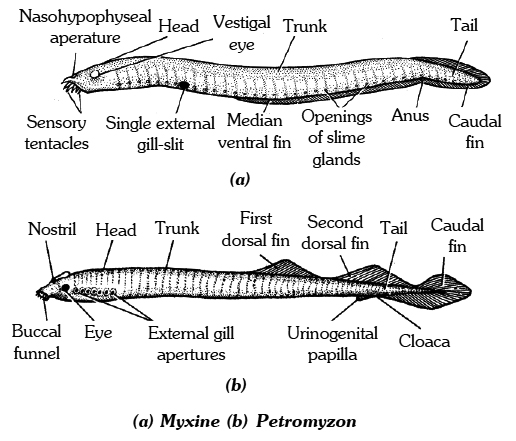
Concept Builder
1. Petromyzon , though marine, goes to fresh water for spawning i.e., anadromous. After spawning within a few days, they die.
2. Larva Ammocoete hatches out of eggs in about 14-21 days. Larval period may long from 3 to 7 years.
3. Ammocoete is connecting link between Amphioxus and the cyclostomes.
4. Lingual Cartilage is also a part of skeleton, that lies in the tongue region and supports it (Lingual = related to tongue).
5. Typhlosole is a fold of epithelium in the intestine. It prevents the rapid flow of food in the intestine and increases the absorptive surface area.
COMPERISION AMONG VARIOUS CLASSES OF VERTEBRATA

Division 2 : Gnathostomata (The Jawed Vertebrates)
It includes advanced vertebrates.
Embryonic notochord is usually replaced in adults by a vertebral column.
Paired fins or limbs are present.
Mouth has jaws hence it is named gnathostomata.
Paired nostrils are present.
Intemal ear has three semicircular canals. Girdles present.
Gnathostomata is divided into two super classes: Pisces and Tetrapoda.
CLASS 1 : PISCES
It includes true fishes. All are aquatic. The body bears fins. They are cold blooded.
(i) Monocondylic skull, slimy glands present on skin.
(ii) Vertebrae are Amphicoelous type
(iii) Neck absent, no upper or lower eyelids, no tympanum (only internal ear is present). Each eye has a well developed nictitating membrane.
(iv) Heart-two-chambered (S-shaped), venous heart with sinus venosus and conus arteriosus.
(v) Both renal portal and hepatic portal system are found. Hypophyseal portal system is also present.
(vi) Respiration occurs typically by gills.
(vii) Scales mesodermal or dermal, embedded in skin.
(viii) Kidneys -Mesonephric, ammonotelic (sharks-Ureotelic).
(ix) Lateral line sense organs are present.
Super class Pisces is divided into three classes :
Class I. Placodermi. (Extinct)
It includes the earliest fossil fishes which lived in fresh water. Body had an external protective armour of bony scales or plates. Primitive jaws with teeth were present. Skeleton was bony. Fins were mostly formed of large spines, e.g., Climatius (Spiny Shark).
(i) They appeared in Silurian period, flourished in Devonian and Carboniferous and became extinct in Permian .
(ii) The name placodermi means "armoured fish" or "Plate skinned".
(iii) Both paired and unpaired fins were present. Caudal fin heterocercal.
(iv) Autostylic jaw suspension; gill slits are covered by operculum.
Class II. Chondrichthyes.
This class includes cartilaginous fish, e.g., Scoliodon (dog fish), Torpedo (electric ray) etc. Sharks are fast swimming predators, whereas, the rays and skates are stout, bottom living scavengers and mollusc feeders.

Class III. Osteichthyes.
It includes bony fish, e.g., Labeo, Hippocampus, Exocoetus, Catla, Clarias, Betta, Pterophyllum etc.

Differences between cartilaginous and bony fishes
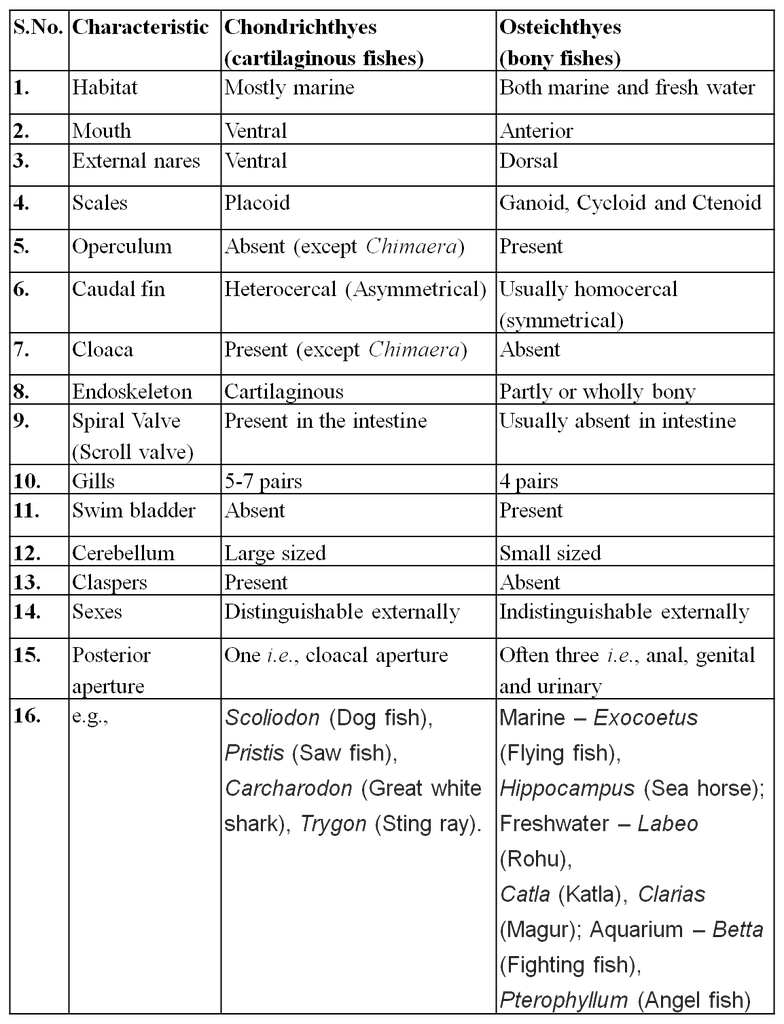
Some Important Fishes
Torpedo (Electric Ray) :
Torpedo is bottom dwelling, carnivorous fish. It stuns or kills the prey and enemies with electric shock from its electric organs. The latter are modified muscles. The skin is scale less.
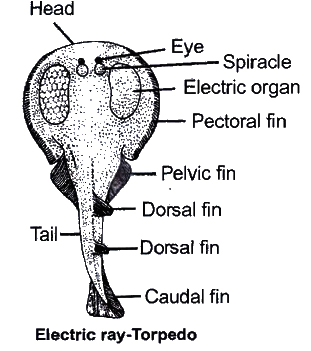
Pristis: (Saw fish)
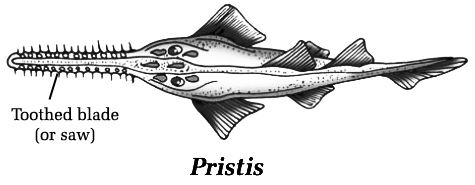
Head bears a series of strong tooth like denticles along the margin.
(a) Freshwater Species (b) Marine Species

Some air breathing fishes, use their paired fins to move on land and gave rise to the first land vertebrates. A living fossil of this group is Latimeria, a lobe-finned fish.
Exocoetus (Flying Fish) :
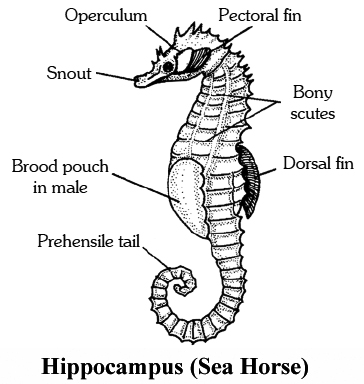
It does not fly but often leaps into the air upto about six metres high. The pectoral fins are modified into wing-like structures, with the help of which the fish glides.
Hippocampus (Sea Horse) :
The neck and the head of the fish are horse like and the tail is prehensile. The male bears a brood pouch in which the female lays eggs and the latter remain there till they hatch.
Labeo (Rohu) :
Labeo rohita and Labeo calbasu are the common fresh water edible carps. It is covered by large overlapping scales.
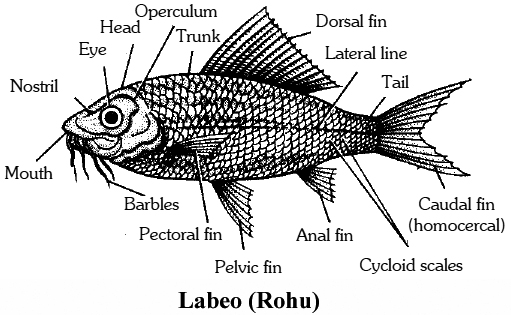
Clarias (Cat fish/Magur) :
Indian Cat Fish (Clarias batrachus) lives in ponds. It is carnivorous. The head bears sensory threads called barbels. The body is smooth and without scales. Other fresh water cat fishes of India are Mystus seengala (slinghara), Rita lita and Wallago attu (Malli).
Latimeria chalumnae (The Coelacanth) :
It was first caught in 1938 off the east coast of South Africa. It swims by curious rotating movements of its pectoral fins. All its fins except the anterior dorsal are lobed. It is the oldest living fish; and has survived till today without undergoing any change in it. It is therefore described as a living fossil.
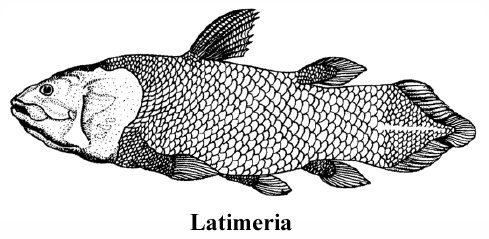
Lung Fishes: Sub-Class Dipnoi
There are three genera of living lung fishes: Neoceratodus, Lepidosiren and Protopterus. All have three chambered heart (two auricles and one ventricle).
4. Fins:
(i) Paired pectoral and pelvic fins: Act as balancers and brakes; provide lift and counteract pitching and rolling.
(ii) Anterior dorsal fin : Counteracts rolling and yawing.
(iii) Posterior dorsal and anal fin : Counteract yawing and rolling.
(iv) Caudal fin : Propels the body and provides lift.
Concept Builder
Types of caudal fins :
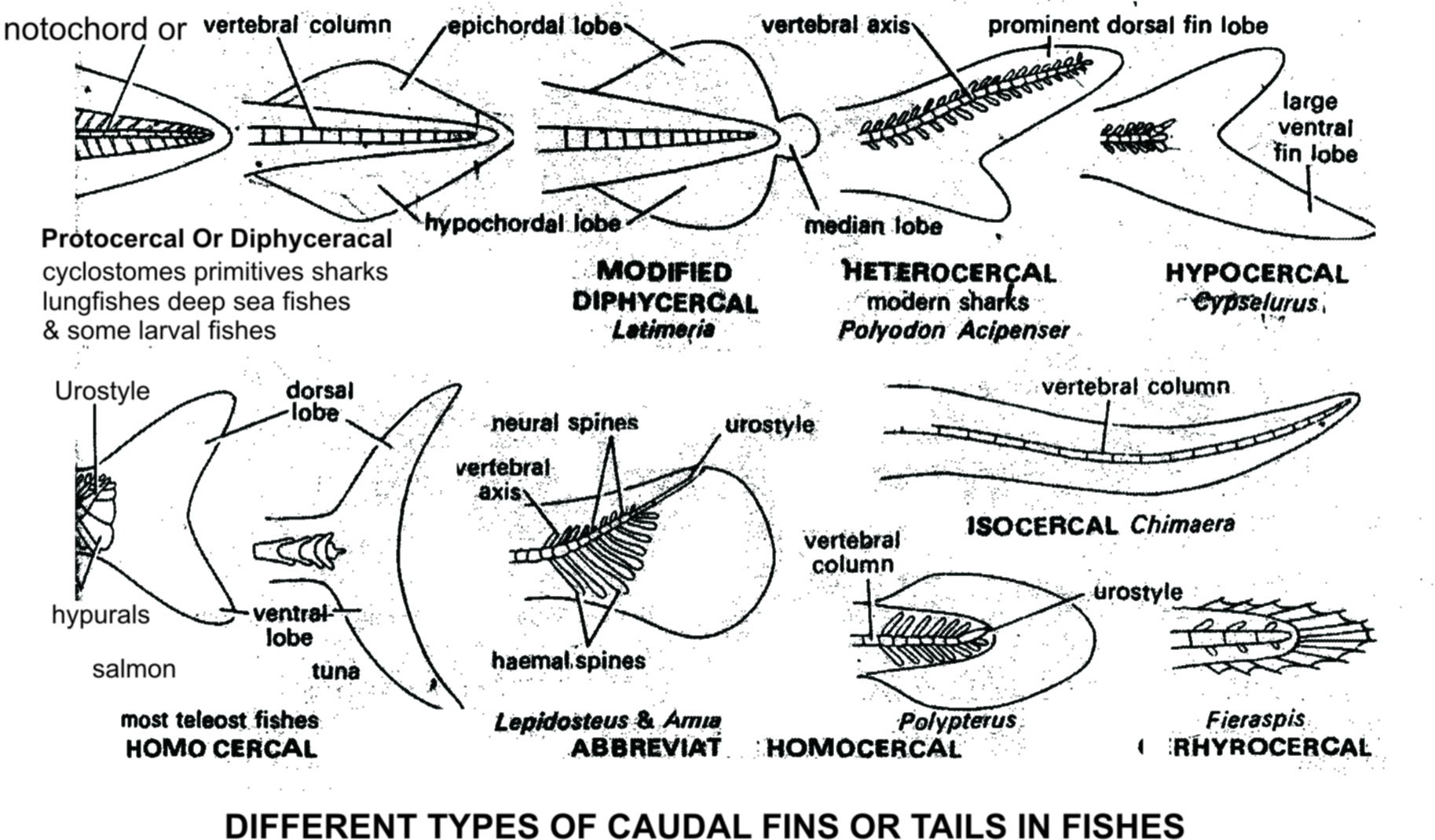
(a) Diphycercal or Protocercal : Most primitive kind of tail fin. The tail is symmetrical, both externally and internally as in protocercal but it is secondarily symmetrical.
(b) Heterocercal/Hypocercal tail: Epicaudal and hypocaudal lobes are of unequal sizes.
(c) Homocercal: Identical lobes. Externally symmetrical and internally asymmetrical.
Endothermic fishes: Although most fishes are ectothermic, a few species, such as blue fish tuna and swordfish are able to maintain a body temperature higher than the temperature of the water that surrounds them. Genetic studies of these endotherms have revealed that the ability to maintain high body temperature gives these fishes an adaptive advantage by allowing them to hunt in much colder waters than their competitors.
Fish taken out of water dies of suffocation due to lack of oxygen. This is because the gill filaments stick together when taken out of water, thereby reducing the surface area.
Word Roots and Origin : Operculum from the Latin meaning "Gover".
5. Scales:
(i) Cosmoid : Absent in living fishes; consists of four distinct layers -outermost ganoine, followed by cosmine, spongy bone and innermost compact bone e.g. extinct fishes.
(ii) Placoid: Backwardly directed spine arising from a basal plate e.g. chondrichthyes only.
(iii) Ganoid or rhomboid scales are thick, diamond or rhomboid shaped plates e.g. primitive bony fishes like Acipencer etc.
(iv) Cycloid: Thin, flexible, circular in outline, marked with concentric lines of growth which can be used for determining age e.g. lung fishes, Amia etc.
(v) Ctenoid: Bear numerous small comb like spines e.g. higher bony fishes like perch etc.
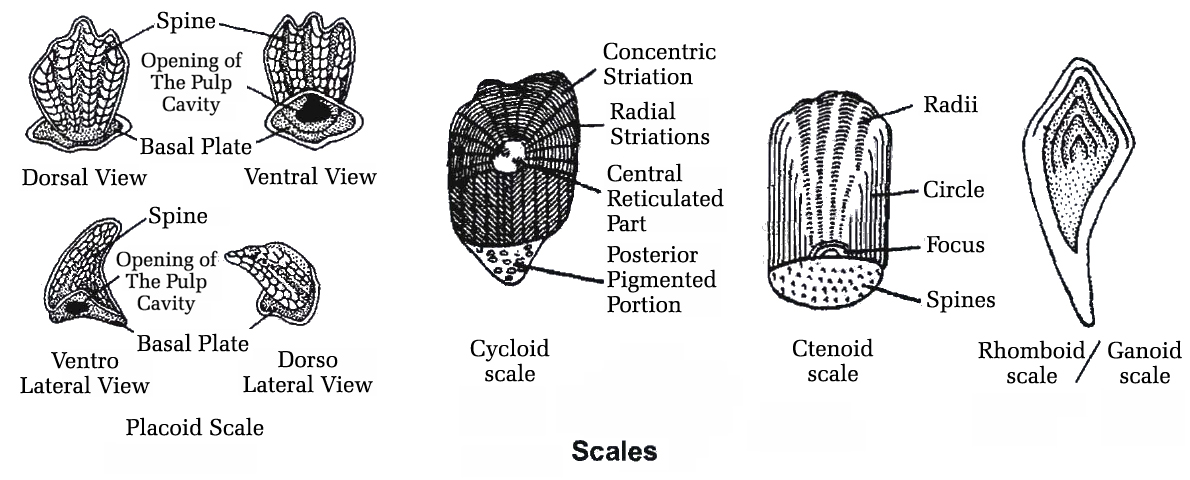
6. Air bladder is associated with respiration, hydrostasis, sound production and audition.
7. Parental care :
(i) Nest building: e.g., Gasterosteus, Amia (bow fin), Protopterus, Lepidosiren (nest is built by males of these fishes).
(ii) Shelter in mouth: e.g., Males of cat fish, Arius.
(iii) Brood pouch: e.g., Male Hippocampus
Common Food Fishes Of India
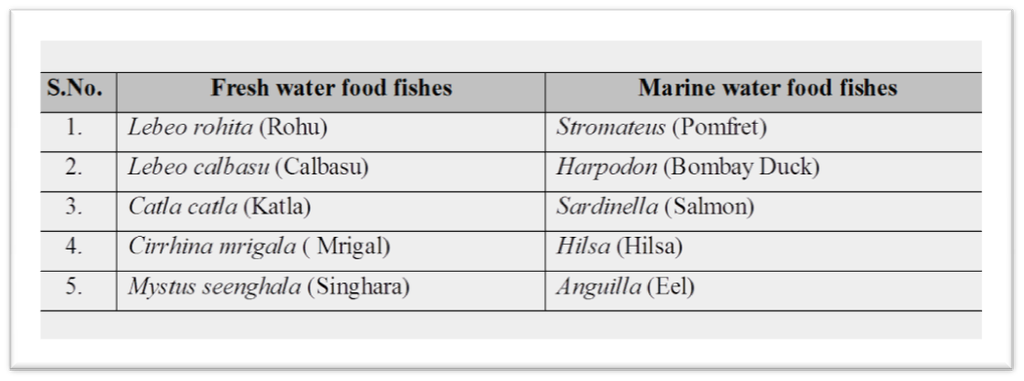
False Fishes
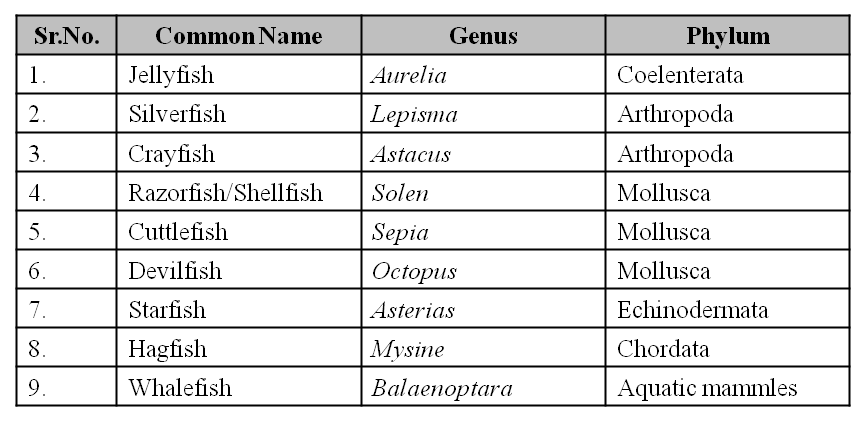
Concept Builder
1. Stone fish is the most poisonous fish.
2. Gambusia fish (Iarvivorous) was introduced into several tropical regions to control malaria.
3. Catadromous fishes live in fresh water and go down to sea for breeding e.g., Anguilla (european eel). When fishes migrate from the rivers to the sea, it is called catadromous migration.
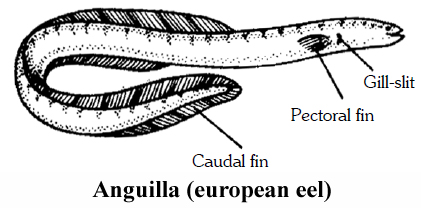
4. Anadromous fishes live in sea water and move to the rivers for breeding e.g., Hilsa, Salmon. When fishes migrate from sea to the rivers, it is called anadromous migration.
5. Hilsa is the only Indian fish that migrates from the seas to the river for breeding.
6. Most primitive fish (fossil): Climatius (Placodermi).
7. Anabas (climbing perch). It has accessory respiratory organs for breathing atmospheric air which enables the fish to take long overland excursions in search of earthworms.
8. Pomfret is the most widely eaten fish in India.
9. Dipnoi have incompletely divided three chambered heart.
10. Urinary bladder is absent in fishes.
11. Some elasmobranchs retain urea in blood to maintian hypertonicity.
12. Ampulla of Lorenzini are thermo receptors.
13. Electric organs of electric ray are modified muscles.
14. Bioluminescent fishes : Anamalops, Porichthyes etc.; Sound producing fishes: Mola, Batistes.
15. Poisonous glands are found in sting ray, eagle ray, Chimaera, Diodon and Tetrodon.
16. Fish byproducts are -Fish meals and fertilizers; fish flour, fish proteins, fish oil, steaming. Floatations, shagreen, fish glue, isinglass, leather, artificial pearls etc.
17. Weberian Ossicles were discovered by Waber (1820). These connect air bladder with internal ear.
18. Commercial name of integument of Scoliodon is "shagreen".
19. Typical trunk vertebrae of fish are amphicoelous, centrum peculiar as is supported by four wedge shaped calcified fibrocartilages forming a "Maltese Cross" and leaving uncalcified area.
20. The study of fish is called Ichthyology.
21. The study of skates, rays and sharks is called Torpedology.
22. Crossopterygians (Rhipidistia -Osteolepis genus) gave rise to amphibia.
23. Parental care is well developed in Hippocampus.
24. Isinglass is a gelatinous product obtained from the air bladders of certain fishes such as carps, salmons, cat fishes etc. It is used for making cements, jellies and for clarification of wines and beers.
25. Types of vertebrae :
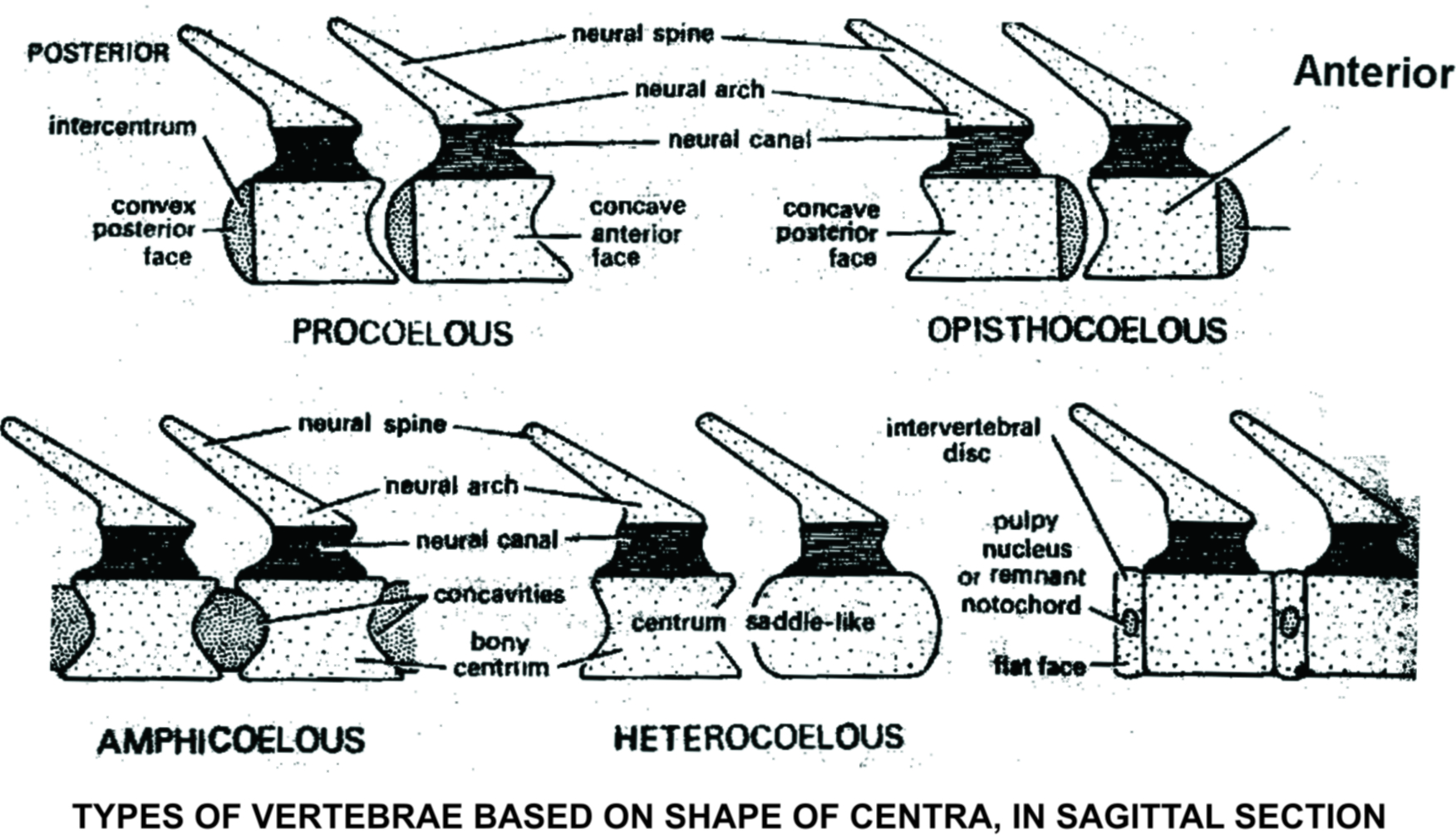
SUPER CLASS 2 (TETRAPODA) :
All gnathostomes excluding fish are included in this super-class.
Typically all tetrapods (Gk. Tetra = four + podos = foot) possess two pairs of limbs. Skin is adapted to withstand exposure to air.
They have lungs for aerial respiration. Their sensory organs are adapted for reception in air, such as vision, hearing, smelling etc.
Tetrapoda is divided into four classes: Amphibia, Reptilia, Aves and Mammalia.
CLASS : AMPHIBIA - The Vertebrates with Dual-life (Gk. Amphi = two or both; bios = life)
General Characters:
There are about 3,000 species of amphibians out of which 2,600 species are in order Anura.
They are present in the warmer regions of the world except Newts and Salamander which are present in cooler regions.
They occur only in fresh water and moist land. Amphibians are not found in sea water.
The other characters are :
1. They are poikilothermal animals. They are amphibious in nature, i.e., they can live on land as well as in water. They are mostly found in warm countries. They are ectothermic (cold blooded). Body is divisible into head and trunk. Tail may be present in some forms.
2. The skin is smooth or rough, having cutaneous glands which keep it moist. They are usually without scales, but if scales are present, they are hidden beneath the skin (e.g., Caecilians).
3. Two pairs of limbs are used for locomotion.
4. The gills are present at least in the larval stage; some adult forms also carry them in addition to lungs (e.g., Necturus).
5. Alimentary canal, urinary and reproductive tracts open into a common chamber called cloaca which opens to the exterior.
6. Skull is dicondylic, i.e., with two occipital condyles for articulation with vertebral column.
7. The respiratory organs are lungs, buccopharyngeal cavity, skin and gills.
8. The heart is three chambered, having two auricles and one ventricle. In the heart, there are present sinus venosus and truncus arteriosus. Both hepatic portal and renal portal systems are well developed.
9. Kidneys are mesonephric. Urinary bladder is present in frog. Larvae and tailed amphibians (e.g., Salamanders) are ammonotelic. Frogs and toads are ureotelic.
10. Ear consists of internal and middle ear. Tympanum (outer membrane) covers the middle ear. The middle ear has a single ear ossicle called Columella Auris.
11. Ten pairs of cranial nerves are present. Sexes are seperate, fertilization is external, oviparous and development indirect.
12. They return towaterfor breeding. Male lacks copulatory organs. Indirect development occurs. A fish like stage, the tadpole is present.
13. Male frog can croak louder than females because of the presence of vocal sacs.
Example : Bufo (Toad), Rana (Frog), Hyla (Tree frog), Salamandra (Salamander), Ichthyophis (Limbless amphibia).
Living Amphibians are divided into three orders:


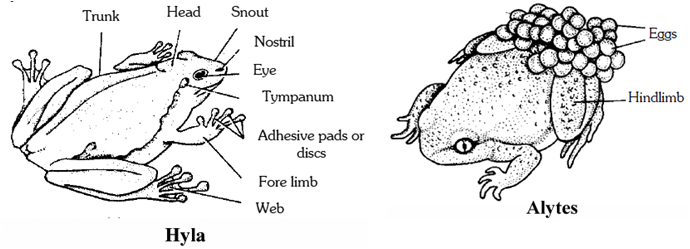

Concept Builder
1. Some frogs have developmen in amazing ways to prevent their eggs from drying out: The female surinam toad of South America carries her eggs in pits/pockets of skin on her back. As many as 60 young pass through the tadpole stage while embedded in her back and then emerge as small frogs.
2. In Frogs, external ears are absent, only Tympanum is seen externally: Frogs have a tympanic membrane on the surface of both sides of their head. The tympanic membrane of a human are called eardrums and each is protected inside ear canal.
3. Word Roots and Origins
(i) Caudata: from latin Caudata meaning "tail"
(ii) Nictitating: from the latin, nictare meaning to "wink"
Concept Builder
1. Seymouria is a connecting link between amphibia and reptiles.
2. Paedogenesis: Development of gonads and/or production of young ones by immature or larval forms e.g. Salamander (Ambyostoma).
3. Total neoteny is shown by Necturus, Siren and Proteus.
4. Toads are used in chinese medicines. Skin of toad secretes a substance that increases B.P when injected into humans.
5. Skin of tadpole secretes an enzyme, diastase.
6. Upper jaw of frog is derived from quadrate cartilage whereas lower jaw is derived from Meckel's cartilage.
7. First toe is called hallux.
8. Jaw suspension is autostylic, urostyle is last component of vertebral column.
9. Shapes of 2-7th vertebrae-Procoelous (typical); 8th vertebra-Amphicoelous; 9th vertebra - Acoelous.
10. Amphiuma-has the largest RBCs among vertebrates.
11. At the time of metamorphosis, the tadpole does not feed.
12. Blind worms (limbless amphibians) are unusual amphibians as only one species lives in water. All the other burrow underground and are rarely seen on the surface. Many do not even need water to breed.
13. Carboniferous Period-UAge of Amphibians".
14. The Arrow poison frogs secretes a powerful poison from the skin which can cause instant death.
15. Most poisonous frog-Golden dart poison frog from South America is the most poisonous frog. One adult frog contains enough poison to kill 200 people.
CLASS : REPTILIA
Their name refers to their creeping or crawling mode of locomotion.
Reptiles are cold blooded or poikilothermic animals.
There are only about 6,000 species of reptiles now living.
But fossils show that 200 million years ago, the reptiles were the most dominant animals on earth.
Herpetology is the study of reptiles.
The largest reptiles today are the 'komodo dragon' Varanus komodoensis of indonesia (a lizard) 3m in length, crocodiles (upto 7m), pythons (upto 10m) and giant tortoises weighing upto 600kg.
Important characters of this class are:
1. They are covered by dry and cornified skin having epidermal scales or scutes. Snakes and lizards shed their scales as 'skin cast'. Scales prevent loss of body water and so reptiles do not require a moist environment like amphibians.
2. Respiration is only through lungs, which is improved by the development of ribs.
3. Limbs -when present are two pairs, pentadactyl, digits have horny claws.
4. Mouth is terminal with conical teeth which are pleurodont in lizards and snakes and thecodont in crocodiles. Teeth are absent and replaced by horny beaks in turtles.
5. Endoskeleton is bony, skull is monocondylic (with one occipital condyle).
6. Heart is usually 3-chambered or partially 4-chambered. Interventricular septum is incomplete. Heart is completely 4-chambered in crocodiles. Two systemic arches are present. Erythrocytes are oval and nucleated.
7. Kidneys are metanephric. Excretion is uricotelic. 'Urinary bladder is absent in snakes and crocodiles.
8. Cranial nerves are 12 pairs. Jacobson's organ (vomeronasal organ) present in the roof of buccal cavity, concerned with smell, is well developed in snakes and lizards. They do not have external ear openings. Tympanum represent ears.
9. Sexes are separate. Males usually have a muscular copulatory organ. Fertilization is internal. Mostly are oviparous and development is direct. Some are viviparous. No metamorphosis.
Example : Chelone (Turtle), Testudo (Tortoise), Chameleon (Tree lizard), Calotes (Garden lizard), Crocodilus (Crocodile), Alligator (Alligator). Hemidactylus (Wall lizard), Poisonous snakes – Naja (Cobra), Bangarus (Krait), Vipera (Viper) etc.
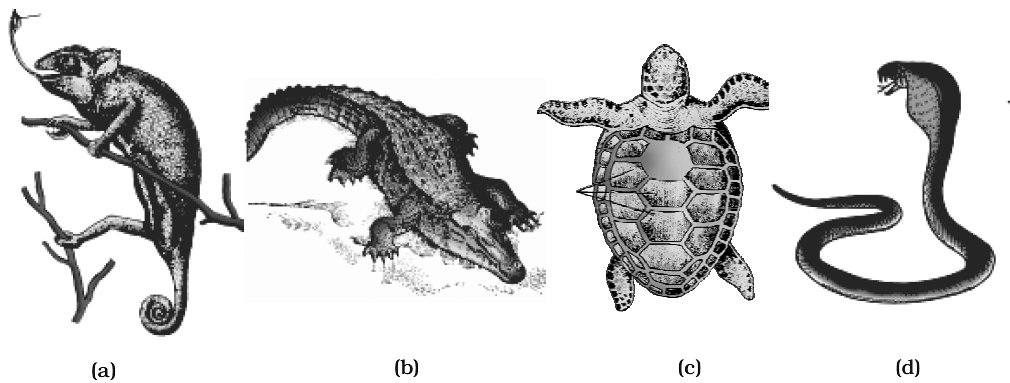
CLASSIFICATION
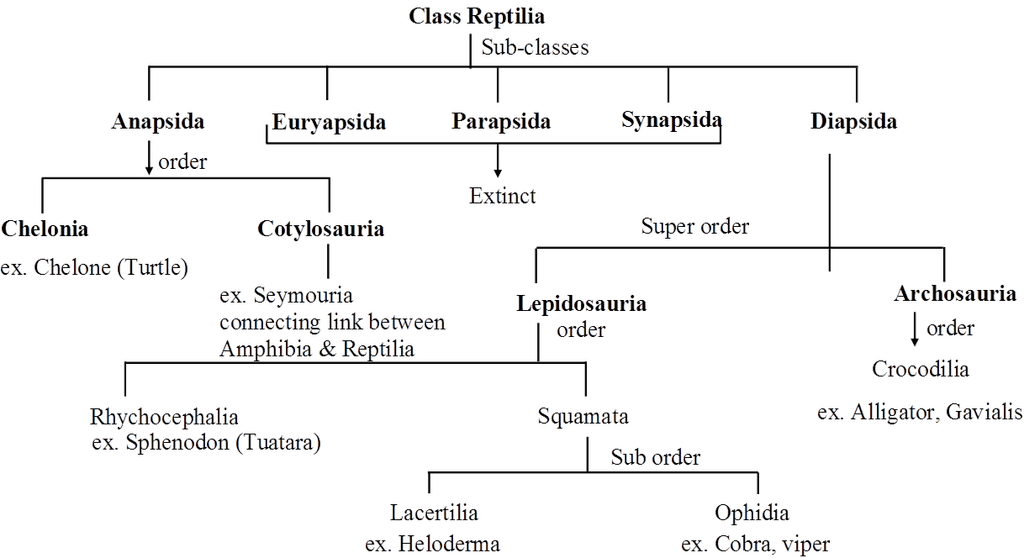
Classification of reptiles is based on temporal fossa on skull. The class reptilia is first divided into 5 sub-classes:
I. Anapsida, II. Euryapsida, III. Parapsida, IV-Synapsida and
V. Diapsida
Out of 5 sub-classes, the living reptiles are found only in two sub-classes,
[A] Anapsida and [B] Diapsida.
Concept Builder
1. Snake Charming :
Contrary to general belief, the snake charmer's cobra does not dance the tune of the flute.
Rather it follows the movement of the tip of the flute and the swaying body of its master, who really moves with the rhythm of the music.
Raising its head and spreading its hood, the cobra gets ready to strike the moving flute tip.
The charmer knows the striking distance and adjusts himself so that the snake orients towards the waving flute but keeps beyond the strike distance.
2. Rattle snake muscles :
Rattle snakes have the quickest moving skeletal muscles in the animal world.
Their tail muscle allows them to shake their rattle 90 times each second.
Most muscles would quickly tire from this kind of energetic activity, but the rattle snake can shake its tail for long periods of time.
The muscle's ability to use ATP in an efficient manner allows it to sustain a high level of activity.
Identification of poisonous and non-poisonous snake

Order: Crocodilia
Differences between Crocodile, Alligator and Gavialis

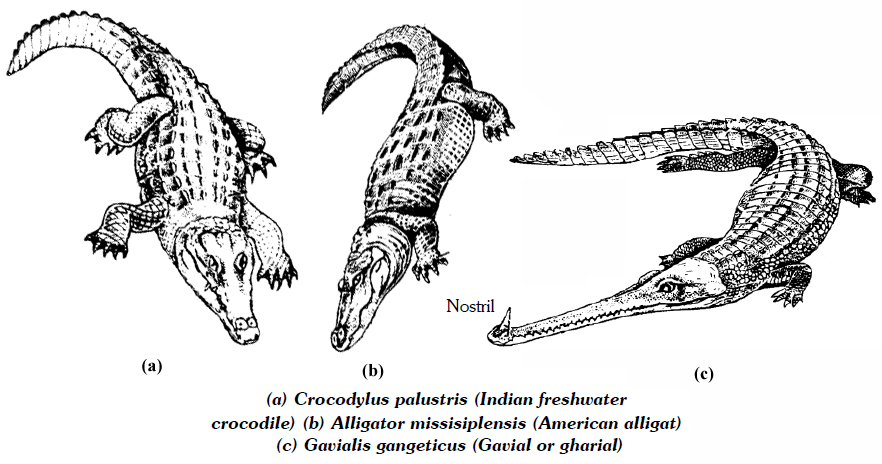
Concept Builder
1. Benadryl is used as an antidote to counteract the effect of haemotoxins.
2. Seymouria is considered as connecting link between amphibians and reptiles.
3. Mesozoic era is known as 'age of reptiles.'
4. Loreal pit of pit viper is thermoreceptor organ.
5. Reptiles without urinary bladder-snakes, crocodiles, alligators.
6. Many sea snakes are viviparous. Pit vipers are also mostly viviparous.
7. The oldest living animal in any Indian Zoo is the Aldabra giant tortoise.
8. Rattle snakes's tail emits a frightening sound which scares away the enemy.
9. The king cobra of India is the only snake in the world that builds a nest.
10. Largest snake-python; Smallest snake-Thread snake.
11. Largest lizard-Komodo dragon; Smallest lizard-Two species of dwarf gecko.
12. Long dinosaur-Diplodocus; Small dinosaur-Compsognafhus.
13. Largest living reptiles (i) Python, (ii) Crocodile (iii) Komodo dragon.
14. Hemidacfylus or wall lizard (Gecko) is a swift runneron smooth vertical surface due to the presence of vaccum pads.
15. Draco is flying lizard but it actually does not fly.
16. Heloderma is a poisonous lizard. (Gila monster)
17. Ophiosaurus known as 'glass snake', 'blind worm', or 'slow worm', limbless lizard.
18. Anguis is also blind worm and limbless.
19. Most Poisonous snake of world-Peninsular Tiger Snake.
20. Poisonous sea snake-Hydrophis
21. Heaviestdinosaurs-Brontosaurus
22. Biggestflesh eater dinosaur-Tyrannosaurus
23. Horned dinosaur-Stegosaurus
24. Varanus-Monitorlizard (largest living lizard).
25. Carapace is hard shield like structure present on the dorsal surface of tortoise and turtle.
26. Reptiles arose in the lower carboniferous time, from Labyrinthodon Amphibia.
27. Varanus is commonly called "Goye" or "monitor"; semi-aquatic; slightly laterally compressed tail.
28. Phrynosoma is found in deserts; called "Horned toad", skin hygroscopic; takes water in the form of dew; exudes red blood-like stream from eyes, whenever, terrified.
29. Iguana is 5-6 feet long; body and tail laterally compressed; arboreal in habit; herbivorous found in tropical America.
30. Sphenodon is the only living genus of Rhynchocephalia. It is commonly called Tuatara. Found only in New Zealand. It is called a living fossil as it resembles with Hanaesaurus of Jurassic age.
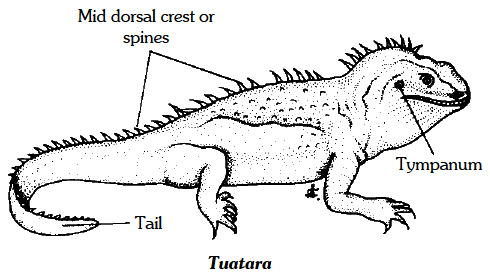
31. Largest living carnivorous reptile is Crocodilus.
32. Thermomorpha is a group of reptiles which are considered to be the ancestors of mammals.
33. Hedonic glands present in males secrete a sticky substance which hardens like spine and helps to hold the mate firmly.
34. Hemipenes-In Uromastix, cloaca possesses a pair of copulatory organs called hemipenes.
35. Russel's viper is the largest Indian viper.
36. Hafkin's Institute of Bombay is the main centre where antivenom is produced.
37. Limbs of Chameleon show syndactyly (fusion of digits) as an adaptation to arboreal life to form opposable finger to hold the twigs.
CLASS : AVES (Birds)
Study of birds is ornithology.
General Characters :
1. Birds are feathered bipeds, air breathing, truly flying veliebrates (other being bats from Class Mammalia).
2. Jaw bones are prolonged into a toothless beak or bill.
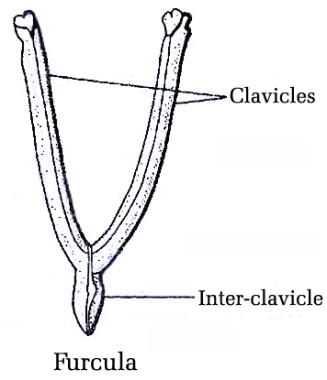
3. Limbs are two pairs. Forelimbs are modified as wings for flying. Hindlimbs or legs are large, each foot usually bears four, clawed toes. Hind limbs generally have scales.
4. Exoskeleton consists of feathers, scales and claws, which are epidermal derivatives. Skin without glands, the only cutaneous gland is uropygial gland or preen gland/oil gland at the base of tail.
5. Oesophagus is dilated into a crop for quick feeding and storage. Crop secretes 'pigeon millt' during breeding season. Stomach is divided into a glandular proventriculus and a muscular gizzard. The junction of small intestine and rectum is marked by a pair of rectal caecae. Cloaca of birds is three-chambered: antenior coprodaeum, middle urodaeum and a large posterior proctodaeum. There is no gall bladder in birds like pigeon.
6. Respiration with compact, spongy, nondistensible lungs continuous with thin walled air sacs. Air sacs reduce body weight, helps in double respiration and internal cooling. Larynx without vocal cords. A sound box or syrinx producing voice, lies at or near the junction Furcula of trachea and bronchi.
7. Heart is completely four-chambered as in mammals. Sinus venosus absent Only right aortic (systemic) arch persists in the adults. Renal portal system is vestigial. Erythiocytes are minute, oval and nucleated. The blood of the birds may be called the richest blood in the animal kingdom. It has more RBCs per cubic mm of blood than in any other animal.
8. Kidneys metanephric and three-lobed. Ureters open into cloaca. Urinary bladder is absent. Excretion is uricotelic.
9. Cranial nerves are 12 pairs.
10. Olfactory organs are poor. Middle ear contains a single ossicle. Eyes possess nictitating membrane, Pecten is a comb-like structure found in the eyes near blindspot. Pecten helps in the nutrition of eyeball. Pecten is found in all birds except Kiwi.
11. Sexes separate. Some birds show sexual dimorphism (e.g. , Parrot and Peacock). Male bird has a pair of abdominal testes and a pair of sperm ducts. A copulatory organ is absent in all birds except in ratitae, geese, ducks etc. Females are oviparous with a single (left) functional ovary and oviduct (Mullerian duct). Development is direct.
Different parts of oviduct secrete the following :
Ostium – Dense albumin
Magnum – White albumin
Uterus – Calcareous shell
Eggs of birds are cleidoic (with calcareous shell), macrolecithal (amount of yolk), meiolecithal (distribution of yolk). Extraembryonic membranes are present (Amniota).
12. Feathers are found only in birds. Feattlers are made up of a protein keratin and are water proof due to the oily secretion of preen glands. The arrangement of feathers on the body of birds is called Pterylosis. The featherless areas are called as Apteria. Four types of feathers are: quill feathers, contour feathers, filoplumes and down feathers. In absence of down feathers the birds will not be able to keep the body warm. Quill feathers in the wings are called 'remiges'. Quill feathers in the tail are called 'rectrices'. Filoplumes and Down feathers help in the insulation of the body.
13. Birds are the first vertebrates to have warm blood. Body temperature is regulated (homoiothermous).
14. Alaspuria -bastardwing -Feathers on 1st digit (thumb).
Example : Corvus (Crow), Columba (Pigeon), Psittacula (Parrot), Struthio (Ostrich), Pavo (Peacock), Aptenodytes (Penguin), Neophron (Vulture).
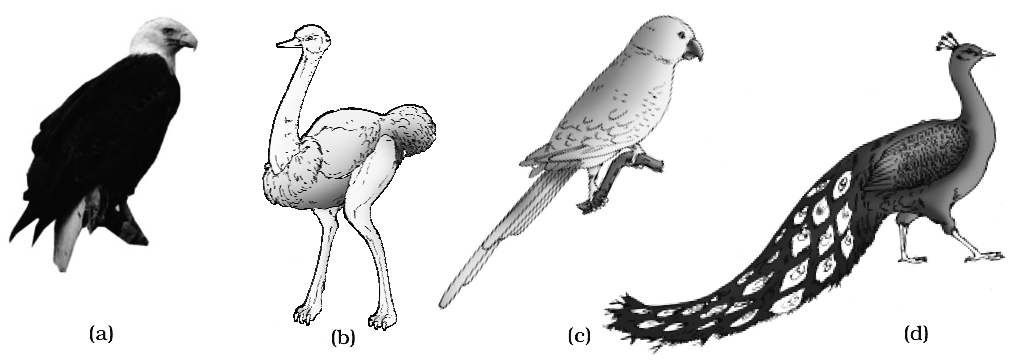
Concept Builder
Types of Feathers
1. Quills:
(a) They are large feathers found in wings and tail.
(b) It has a central axis called shaft.
(c) Small proximal part of the shaft is hollow, translucent and cylindrical and is termed as calamus.
(d) The long-distal, solid and opaque part of the stem is known as rachis.
(e) An umbilical groove extends all along the ventral side of rachis.
(t) Small hole on the proximal end of calamus is known as inferior umbilicus, the hole on the distal end of calamus is known as superior umbilicus.
(g) Each vane is composed of parallel filaments, the barbs. Each bears barbules.
(h) The distal barbules of each barb bear small hooklets.
(i) Emu bird have an after shaft as long as the main shaft.
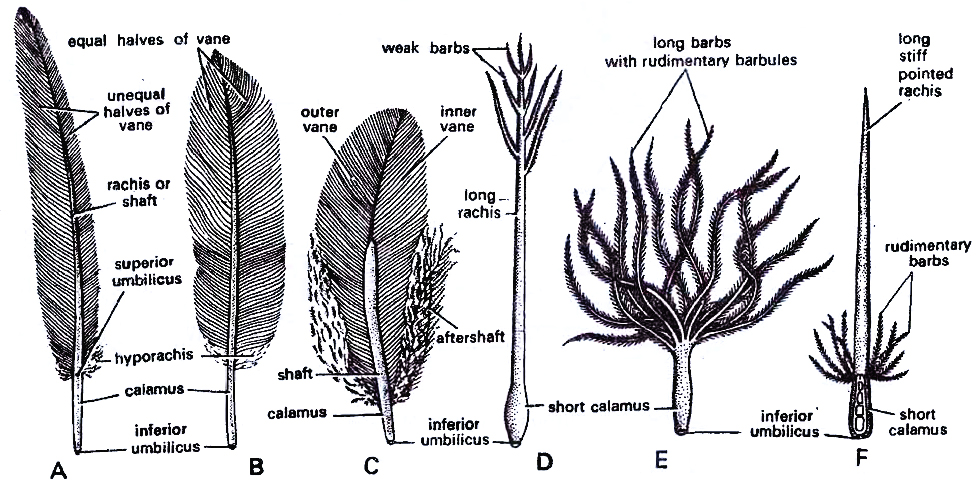
2. Coverts are small feathers found in the wings and tail. They fill up the gaps left between the bases of the quills. They have short calamus in comparison to quills.
3. Contours: Small feathers that cover the body and give it its shape. They resemble the quills but their barbs are not so strongly joined and can be separated easily.
4. Filoplumes: Occur beneath contour feathers, very small in size, consists of long rachis bearing at the tip a few weak free barbs with barbules.
5. Down feathers/Nestling downs: They cover the newly hatched bird. They consist of short calamus, reduced rachis bearing flexible barbs with short barbules. They are found beneath contours.
6. Bristles: Short calamus, a long rachis bearing a few vestigeal barbs at its base. Bristles occur nearthe mouth in fly-catchers.
7. The first digit of the hand (thumb or pollex), bears a tuft of small feathers known as bustard wing or alaspuria or false wing.
CLASSIFICATION
Class Aves is divided into two sub-classes: Archaeornithes and Neornithes.
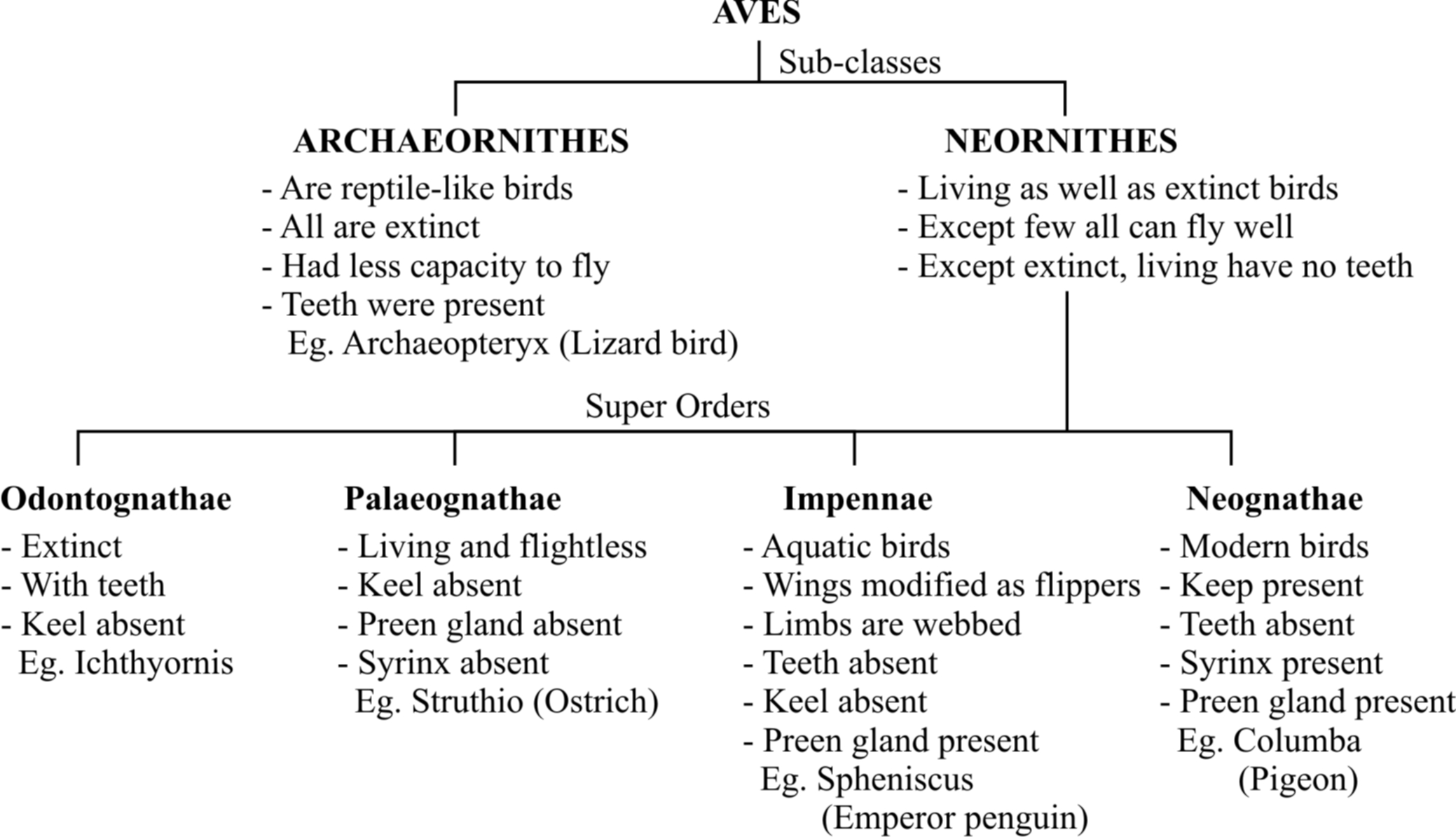
 Sub-class I : Archaeornithes
Sub-class I : Archaeornithes
1. All extinct Jurassic period birds of Mesozoic era.
2. Wings primitive with little power of flight.
3. Tail long, lizard-like with two lateral rows of rectrices.
4. Hand with clawed fingers.
5. Skull with teeth in both jaws e.g., Archaeopteryx.
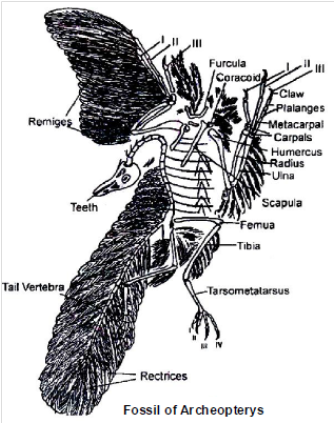
Sub-class II : Neornithes
1. Modern as well as extinct, post-Jurassic period birds.
2. Wings well developed and adapted for flight (with few exceptions).
3. Tail short and reduced.
4. Teeth absent except in some fossil birds.
5. Sternum with keel or carina.
There are four super orders in this subclass :
Super-order I : Odontognathae
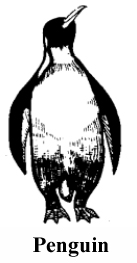
e.g., Hesperornis (with teeth) extinct.
Super-order II : Palaeognathae (Ratitae)
e.g., Flightless running birds
Super-order III : Impennae
e.g., Penguins (Aptenodytes)
Penguins are found in Antarctica (South pole). They have paddle-like wings and cannot fly. Penguins are marine and lay eggs in ice.
Super-order IV : Neognathae (Carinatae)
e.g., Modern flying birds as Columba (pigeon), Psittacula (parrot), Neophron (vulture), Pavo (peacock).
Conceptual Questions
Q.1 Why might it be a disadvantage for an eagle to have a urinary bladder?
Q.2 Why might teeth be a disadvantage to a bird?
Ans. 1. Urine contains a greater amount of water, which is heavy. The extra weight would be a disadvantage in flight.
2. Teeth are heavy and require heavy jaws.
Concept Builder
1. Brood Parasite : Eudynamis (koel, kokila). The male sounds like kuoo-kuoo-kuoo. The female is generally heard during breeding season and has short and sharp call kik-kik-kik, otherwise she is mostly silent. It does not make any nest but lays eggs in the crow's nest. In this way koel is nest parasite. Male is black. Female is brown and profusely spotted barred with white Koel is known as the Indian nightingale because of its pleasant sound.
2. Eagle-Eyes: Eagles have much better vision than humans do. The birds keen eyesight allows it to see prey at great distances. Its visual acuity is 3-4 times higher than ours.

 Differences between Ratitae and Carinatae
Differences between Ratitae and Carinatae
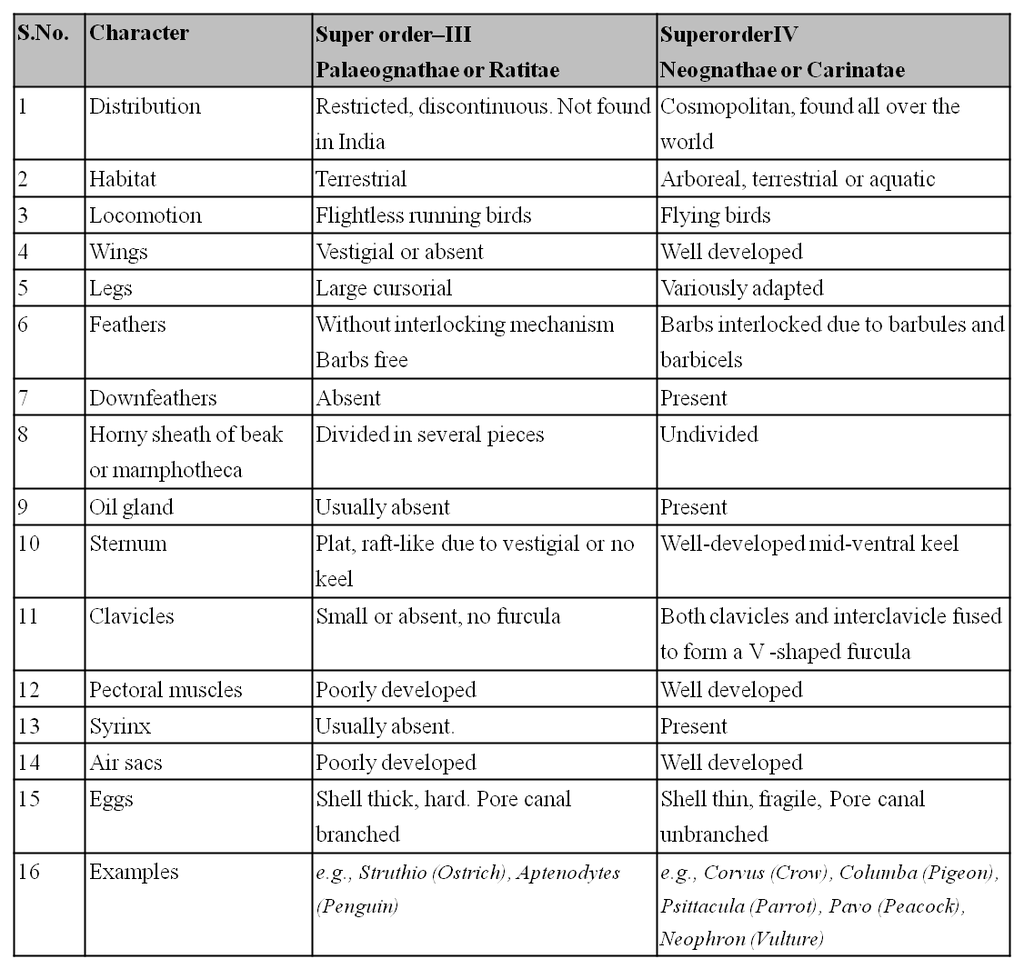
Concept Builder
1. Largest bird-Struthio camelus -8 feet height, 300 Lbs weight.
2. Smallest bird -Mellisuga helenae-5.5 cm long.
3. Smallest egg of bird-Mel/isuga (Humming bird).
4. The humming bird is the only bird which can fly backward as well as forward.
5. Largest egg of bird-Struthio-1.5 Litre capacity.
6. Largest sea bird-Diomedea epomorphora (Royal albatross) wing stretch 200-375 cms.
7. Deepest Diver bird-Aptenodytes torsteri (Emperor Penguin)
8. Fastest Swimmer bird-Pygoscelis papua (Penguin)
9. Fastest Runner bird-Struthio-60 kms/hr. speed.
10. Heaviest bird of prey-Vulture gryphus.
11. Fastest Flying bird-Swift-rarely touch the earth.
12. Second largest bird is Emu (Dromaeus) as is most primitive living bird.
13. Recently extinct bird is Dodo (Passenger birds) of Mauritius.
14. Incubation period of Hen's egg at 102°F (38.8°C) is 21 days.
15. Though polygamy is common in birds, Emu is strictly monogamous.
16. Penguins are flightless birds found in Antarctica, wings are paddle-like, act as flippers during swimming and are covered by scale-like feathers.
17. T.H. Huxley said "birds are glorified reptiles". The feathers are highly modified reptilian scales. Birds have scales on their legs. Their eggs resemble reptilian eggs in general but have a calcareous shell.
18. Among the Indian birds the sun birds are probably the smallest.
19. The Bursa Fabricii is a blind sac with much lymphoid tissue in the cloaca of some young birds. It produces lymphocytes (a type of white blood corpuscles). It is also called "cloacal thymus".
20. Columbia has the world's richest diversity of birds. '.
21. Uropygium (tail)-the projecting terminal portion of a bird's body from which the tail feathers arise.
22. Swifts use saliva for binding nest materials.
23. Kiwi lays the largest egg in proportion to its own size.
24. Himalayan Bearded Vulture is the largest Indian bird. Previously the Sarus was considered the largest Indian bird.
25. Ostrich has the largest eyes of any land animal.
26. Kiwi is the only bird known to use the sense of smell for finding food on the ground.
27. Indonesia has the most bird species facing extinction.
28. Red Billed Quelea (Quelea quelea) of Africa are the most abundant birds. Previously the house sparrow was considered the most abundant species of birds.
29. Jatinga is a village in Assam where a mass suicide of birds occurs.
30. The owl rotates its head through an angle of 2700 as its eyes do not rotate in their sockets. Each eye is fixed like a car headlight.
31. Copulatory organ (true penis) is present in ostrich, duck, swan and goose.
32. Famous Indian Ornithologist-Dr. Salim Ali.
33. National bird-Pavo cristatus (Peacock).
CLASS : MAMMALIA
They are terrestrial, warm-blooded (endothermous) or homeothermal animals so that their body temperature remains constant inspite of the changes in the temperature of the environment.
General characters of this class are :
1. The skin is covered with epidermal hair which acts as an insulating layer and allows high body temperature to be maintained. The hair may be partly lost as a secondary adaptation. In some aquatic mammals where hair is negligible, there is a subcutaneous layer of heat which provides insulation of heat and makes the warmblooded condition possible.
2. The skin has two kinds of glands, sudorific glands which produce sweat -evaporation of sweat controls the body temperature; second kind of glands are sebaceous glands which produce an oily secretion which makes the hair water-resisting. Modified sweat glands (sudoriferous) form mammary glands which produce milk in the females for nourishment of the young for some time after birth. Because they possess mammae (breasts) and mammary glands, they are called mammals. It is the most unique character of mammals.
3. Them is an external ear or pinna with an external auditory meatus. This is in addition to middle and internal ear.
4. In higher mammals, the anus is separated from the urinogenital aperture; consequently urinary and genital ducts have no connection with the digestive tube.
5. In males, testes have come to lie outside the body cavity in scrotal sacs (except in elephants and aquatic mammals and prototherian mammals).
6. Teeth are embedded in sockets of the jaw bone and are said to be thecodont. There are only two sets of teeth in life time, one deciduous or milk set and another permanent set, this condition is spoken of as diphyodont. There are four different types of teeth, hence mammals are heterodont.
7. A muscular diaphragm divides the coelom into a thoracic and an abdominal cavity; the thoracic cavity has a pericardial cavity containing the heart and two pleural cavities containing the lungs, the remaining viscera lies in the abdominal or peritoneal cavity.
8. The heart is 4-chambered with two auricles and two ventricles so that oxygenated blood lies in the left half and deoxygenated blood in the right half. This condition is also found in birds. Only the left aortic arch is present. Erythrocytes are round, biconcave and non-nucleated (except in camel where they are oval and non-nucleated).
9. Cerebral hemispheres and cerebellum are large-sized and highly developed with great increase in the cortex. The two cerebral hemispheres are joined by a transverse band of nerve fibres called corpus callosum. There are four solid optic lobes called corpora quadrigemina in the mid-brain. 12 pairs of cranial nerves.
10. The middle ear has three ear ossicles called malleus, incus and stapes; the internal ear has a spirally coiled cochlea as an efficient organ of hearing.
11. The neck generally has seven cervical vertebrae.
Example : Oviparous-Ornithorhynchus (Platypus); Viviparous -Macropus (Kangaroo), Pteropus (Flying fox), Camelus (Camel), Macaca (Monkey), Rattus (Rat), Canis (Dog), Felis (Cat), Elephas (Elephant), Equus (Horse), Delphinus (Common dolphin), Balaenoptera (Blue whale), Panthera tigris (Tiger), Panthera leo (Lion). etc.
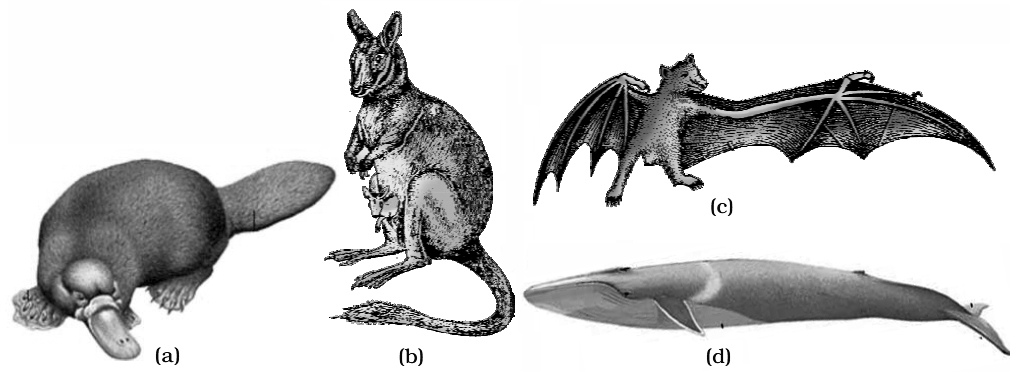
DIFFERENCE BETWEEN THREE GROUPS OF MAMMALS

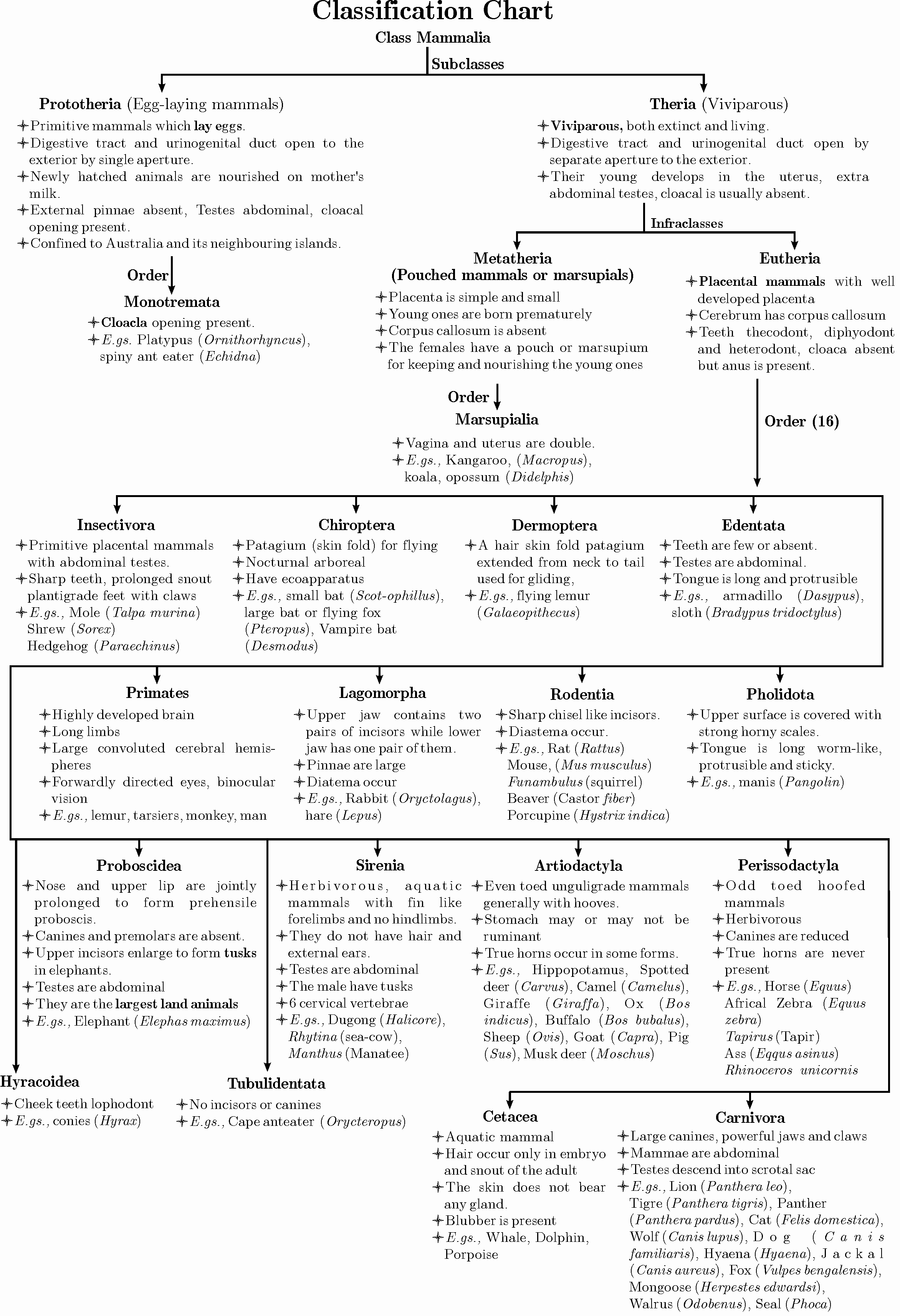
Concept Builder
1. How many vertebrae do giraffes have in their neck?
Most of the vertebrates, including giraffes and camel, have seven cervical (neck) vertebrae. At almost 6 m (20 ft) tall, the giraffe is the tallest of all vertebrates and its seven cervical vertebrae are greatly elongated
Exception : 3 toed sloth (Bradypus) with 9 cervical vertebrae and Manatee is with 6 neck vertebrae.
2. Armadillos : The nine-banded armadillo (Dasypus) is one of the few mammalian species whose range is expanding. In late 1800s, they lived only as far north as central Texas. Leprosy bacteria is cultured in the armadillos (Dasypus).
Concept Builder
1. Man remains plantigrade at rest or during locomotion. Uses only the toes for running, thus is called sub plantigrade.
2. Colour of human skin is yellow to orange due to carotene pigment in cells of stratum corneum and subdermal fat cells. Melanin is found in melanocytes.
3. In man sweat glands are absent at lip borders, clitoris, glans penis, nail beds, under surface of prepuce.
4. Sweat or sudoriferous glands secrete sweat. Sweat comprises of 95% water and 5% metabolic waste.
5. Spiny ant eater, scaly ant eaters, moles, cetaceans, sirenians and some edentates do not possess sweat glands.
6. Tusks of elephants are two incisors of upper jaw which constantly grow throughout life.
7. Man ![]()

8. Dog ![]()

9. Cat ![]()

10. Rat ![]()

11. Horse ![]()

12. Elephant ![]()

13. Primates such as monkeys, man, apes, etc., acquired 3 dimensional vision due to their most evolved motor understanding of visual sensation.
14. Deer, amongst vertebrates, proportionately to their body size, possess largest eyes.
15. Carnassial Teeth. Special shearing teeth in carnivores for cracking bones-4th premolar of upper jaw and first molar of lower jaw.
16. Milk Producing Male Mammal. Spiny Ant Eater/Echidna.
17. Monotreme. With a single aperture of cloaca for urinogenital and digestive tracts.
18. Largest Land Animal. Loxodonta africana/African Elephant. Height 3.5 m and weight 7 tonnes.
19. Tallest Land Animal/Mammal. Giraffe, upto 6 m.
20. Mouse and Rat. Mouse and Rat has first molar bigger than combined 2nd and 3rd molars.
21. Zebra Stripes. Stripes of no two zebras are alike.
22. Fastest Mammal. Acinonyx jubatus/(Cheetah) (extinct from India but present in Africa). Speed upto 100 km/hr.
23. Slowest Terrestrial Mammal. 3-toed Sloth/Bradypus, Tridactylus, 100-150 m/hr.
24. Slowest Aquatic Mammal. Sea Otter/ 10 km/hr.
25. Longest Gestation Period in Mammal. 609 days/20 months in Elephas maximus.
26. Shortest Gestation Period in Mammal. Opossum. 12-13 days.
27. Hom. Matted hair in Rhino. Antlers are solid, shed and regrown every year.
28. Tiger. Panthera tigris is National animal of India (declared in 1973).
29. Today Marsupials are found mainly in Australia except a few marsupials such as the American opossum are found outside that continent.
30. Rabbit is digitigrade because it moves on digits.
31. Plantigrade mammals are those whose palm and sole touch the ground when moving from one place to another e.g., bears and certain insectivores.
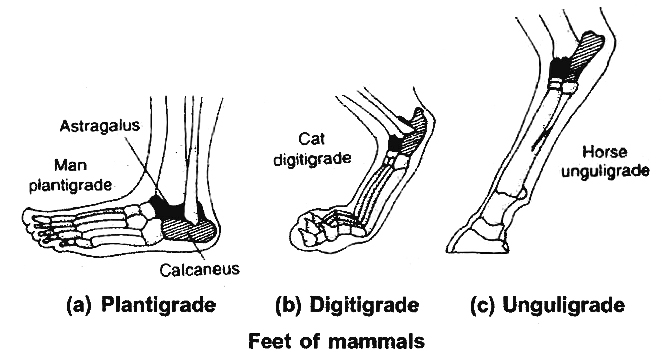
32. Unguligrade mammals are those whose only the tips of one or two fingers and toes remain in contact with the ground both at rest and locomotion. These are fastest running terrestrial mammals e.g., horses, deers, cows, donkeys etc.
33. Hides are prepared from dermis of animal skin.
34. Seals and whales have scanty hairs because heat insulation is done by blubber.
35. Horns of rhinoceros, scales of scaly ant eater and spines of porcupine are derivatives of hairs.
36. Retina of owls contains only rods (suitable for nocturnal habit). Also, the same occurs in shrews, hedge hog, rodents, bats etc.
37. Retina of fowls contains only cones (suitable for diurnal habit). Squirrels also have only cones.
38. Whales, mice, shrews and also some other mammals, but not rabbit and man, posses Harderian gland like that of frog.
39. Scrotum of mammals contains testes, in most of the mammals; this is a thermostatic chamber for testes and lies outside the abdominal cavity because sperms cannot develop in body temperature. Thus, these become close, if the temperature falls more than 2°C or come apart from the body, if temperature rises more than 2°C.
40. In insectivores, chiroptera and rodentia scrotum is formed only during breeding season, later move to abdominal cavity e.g., bat, otter.
41. Insectivores, edentates, proboscidians (elephants), cetaceans (whales) always have their testes inside the body cavity.
SUMMARY
1. Phylum Chordata includes animals which possess a notochord either throughout or during early embryonic life. Other common features observed in the chordates are the dorsal, hollow nerve cord and paired pharyngeal gill slits.
2. Some of the vertebrates do not possess jaws (Agnatha) wheares most of them possess jaws (Gnathostomata). Agnatha is represented by the class Cyclostomata. They are the most primitive chordates and are ectoparasites on fishes.
3. Gnathostomata has two super classes. Pisces and Tetrapoda. Classes chondrichthyes and osteichthyes bear fins for locomotion and are grouped under pisces. The chondrichthyes are fishes with cartilaginous endoskeleton and are marine and Osteichthyes class includes bony fishes.
4. Classes Amphibia, Reptilia, Aves and Mammalia have two pairs of limbs and are thus grouped under Tetrapoda. The amphibians have adapted to live both on land and water. Reptiles are characterised by the presence of dry and cornified skin. Limbs are absent in snakes. Fishes, amphibians and reptiles are poikilothermous (cold-blooded). Aves are warm-blooded animals with feathers on their bodies and forelimbs modified into wings for flying. Hind limbs are adapted for walking, swimming, perching or clasping. The unique features of mammals are the presence of mammary glands and hairs on the skin. They commonly exhibit viviparity.
phylum chordata
Phylum Chordata
This is the third most populous phylum in the animal kingdom. The existence of a notochord, a dorsal hollow nerve cord, a post-anal tail, and paired pharyngeal gill slits distinguishes animals belonging to the phylum Chordata. These are bilaterally symmetrical, triploblastic, coelomates that are organized at the organ-system level. Their circulatory system is closed. The Chordata phylum is subdivided into three subphyla:
The Chordata phylum is subdivided into three subphyla:
(a) Urochordata or Tunicata: Examples: Ascidia, Salpa, and Doliolum;
(b) Cephalochordata: Example: Branchiostoma; Amphioxus or Lancelet
(c)Vertebrata: Example: Horse, Humans
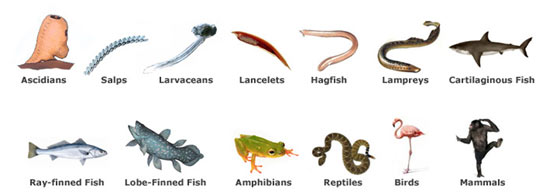
Subphyla Urochordata and Cephalochordata are collectively referred to as protochordate andare only found in the ocean. The notochord is only present in the larval tail of Urochordata, but it extends from the head to the tail area of Cephalochordata and is present throughout their lives.During the embryonic period, members of the Vertebrata subphylum have a notochord. In adulthood, the notochord is replaced by a cartilaginous or bony vertebral column. All chordates are vertebrates, however, not all chordates are vertebrates. Vertebrates have a ventral muscular heart with two, three, or four chambers, kidneys for excretion and osmoregulation, and paired appendages that can be fins or limbs.
The subphylum Vertebrata is further divided as shown below:
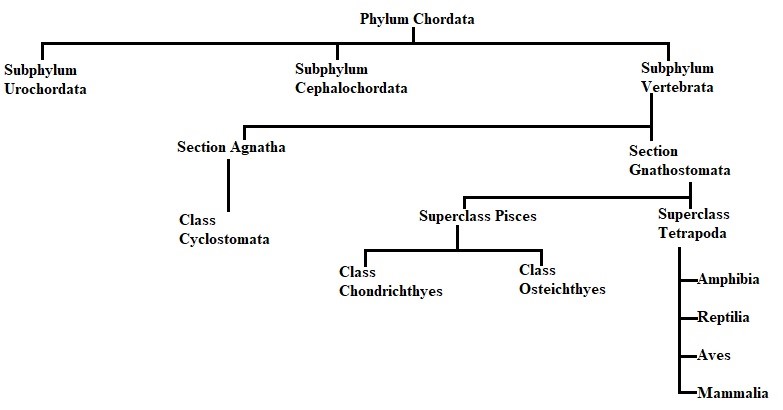
Agnatha comprises jawless organisms which consist of only one subdivision, Cyclostomata. Gnathostomata comprises animals having jaws and can be further divided into fin-bearing Pisces and limb-bearing Tetrapods.
A. Class Cyclostomata: Cyclostomata comprises loving members of the class who are ectoparasiteson some fishes. For respiration, they have an extended body with 6-15 pairs of gill slits. Cyclostomes have a circular sucking mouth with no jaws. Scales are missing from their bodies, and they have paired fins. The cranium and spinal column are made of cartilage. The circulation is closed. Cyclostomes are marine creatures that travel to freshwater to procreate. They die within a few days of spawning. After metamorphosis, their larvae return to the sea. Petromyzon (Lamprey) and Myxine (Hagfish) are two examples.
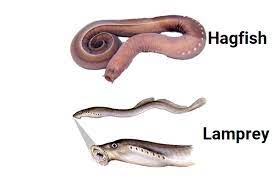
B. Class Chondrichthyes: They are streamlined aquatic organisms with a cartilaginous endoskeleton. The mouth is situated ventrally. The notochord remains throughout life. Gill slits are distinct and lack an operculum (gill cover). The skin is robust and covered in little placoid scales. Teeth are modified placoid scales that point backward. Their jaws are extremely strong. These creatures are predators. They must swim frequently to prevent sinking due to the lack of an air bladder. It has two chambers (one auricle and one ventricle). Some have electric organs (such as Torpedo) and others have poison stings (e.g., Trygon). They are cold-blooded (poikilothermous) animals, meaning they can't control their body temperature. Sexes are distinct. Males have claspers on their pelvic fins.Internal fertilization is present, and many of them are viviparous. Scoliodon(dogfish), Pristis (sawfish), Carcharodon (great white shark), and Trygon(Stingray)are among examples.
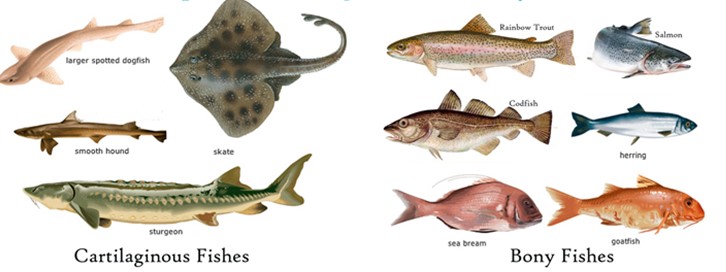
C.Class Osteichthyes: With a bony endoskeleton, it contains both marine and freshwater fish. Their physique is slim. The mouth is primarily terminal. They have four pairs of gills on each side, which are covered by an operculum. Cycloid/ctenoid scales cover the skin. The presence of an air bladder influences buoyancy. A two-chambered heart (one auricle and one ventricle). They're cold-blooded creatures. Sexes are distinct. External fertilization is common. They are generally oviparous and have a straight development. Examples includeFreshwater – Labeo (Rohu), Catla (Katla), Clarias (Magur); Marine – Exocoetus (Flying fish), Hippocampus (Sea horse); Aquarium – Betta (Fighting fish), Pterophyllum(Angelfish).
D. Class Amphibia: Amphibians can survive in both aquatic and terrestrial environments. They all have two sets of limbs. The body is divided into two parts: head and trunk. Some individuals may have a tail. The skin of amphibians is wet (without scales). Eyelids cover the eyes. The ear is represented by a tympanum. The alimentary canal, urinary system, and reproductive tract all open into a single chamber called the cloaca, which is visible from the outside. Gills, lungs, and skin are all used to breathe. There are three chambers in the heart (two auricles and one ventricle). They are cold-blooded creatures. Sexes are distinct. External fertilization is used. They are oviparous and have indirect development. Bufo (toad), Rana (frog), Hyla (tree frog), Salamandra(salamander), and Ichthyophis (Limbless amphibian) are a few examples.
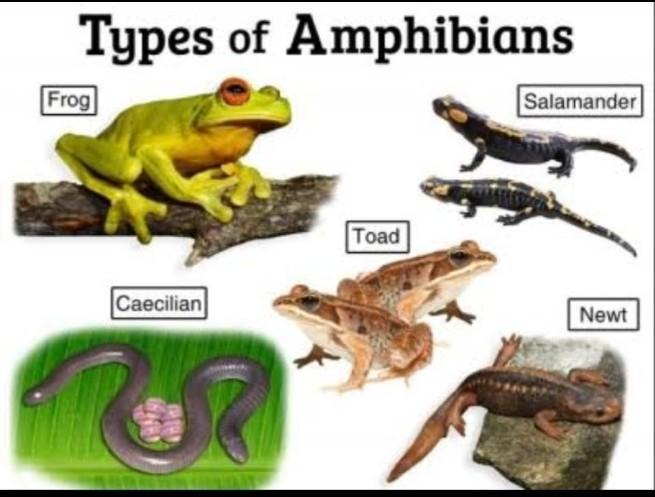
E. Class Reptilia: This class includes organisms having to creep or crawla mode of locomotion. They are generally terrestrial animals with dry, cornified skin, epidermal scales, or scutes covering their bodies. External ear holes are not present. Tympanum stands for the ear. Limbs are two pairs when present. Crocodiles have four chambers in their hearts, which are usually three. Reptiles are Poikilotherms. As skin cast, snakes and lizards shed their scales. Sexes are distinct. Internal fertilisation. They are oviparous and have straight development. Chelone (turtle), Testudo (tortoise), Chameleon (tree lizard), Calotes (garden lizard), Crocodilus (crocodile), and Alligator are just a few examples. Poisonous s.nakes — Naja (Cobra), Bangarus (Krait), Vipera, (Viper) etc. are also known as reptiles.
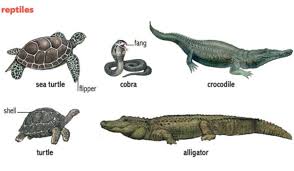
F.Class Aves: The presence of feathers distinguishes Aves (birds), and most of them can fly, except flightless birds (e.g., Ostrich and Emu). They have a beak. The forelimbs have been transformed into wings. Scales cover the hind limbs, which are modified for walking, swimming, and grasping tree branches. Except for the oil gland at the base of the tail, the skin is dry and lacks glands. The long bones are hollow with air spaces, and the endoskeleton is entirely ossified (bony) (pneumatic). The crop and gizzard are extra chambers in the digestive tract of birds. The heart has four chambers in total. They are warm-blooded (homoeothermic) creatures, which means they can keep their body temperature constant. Lungs are used to breathe. Respiration is aided by air sacs attached to the lungs. Sexes are distinct.Internal fertilization is present. They are oviparous and have direct development. Corvus (Crow), Columba (Pigeon), Psittacula (Parrot), Struthio (Ostrich), Pavo (Peacock), Aptenodytes (Penguin), and Neophron (Vulture) are some examples.
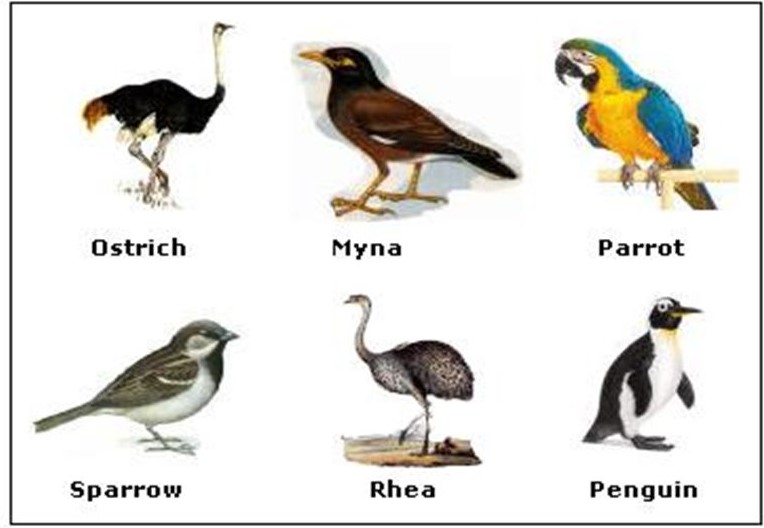
G. Class Mammalia: In the phylum Chordata, Mammalia is the most developed class. Polar ice caps, deserts, mountains, woods, grasslands, and gloomy tunnels are all places where mammals can be found. Some have developed the ability to fly or live in water. The existence of milk-producing glands (mammary glands), which nourish the young, is the most distinguishing mammalian trait. They have two pairs of limbs, one for walking, the other for running, climbing, digging, swimming, and flying. Mammalian skin is remarkable in that it has hair. External pinnae or ears are present. The jaw contains a variety of tooth kinds. The human heart has four chambers. They're the same temperature. Lungs are used to breathe. Sexes are distinct, and fertilization takes place internally.
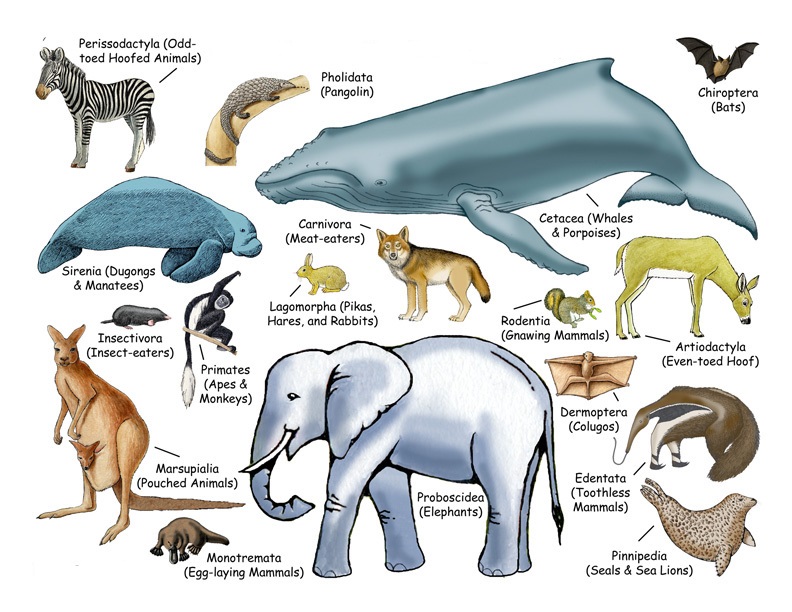
With a few exceptions, they are viviparous and develop directly. Macropus (Kangaroo), Pteropus (Flying fox), Camelus (Camel), Macaca (Monkey), Rattus (Rat), Canis (Dog), Felis (Cat), Elephas (Elephant), Equus (Horse), Delphinus (Common dolphin), Balaenoptera (Blue whale), Panthera tigris (Tiger), Panthera leo (Lion).

 ACME SMART PUBLICATION
ACME SMART PUBLICATION
